The JAE and ACSA recognize the critical need to support the scholarship of architectural educators and researchers who face and continue to encounter systemic and structural obstacles, including racism, within academia and beyond. As a step toward this commitment, we have established one-year Fellowships and online publication commitments for cohorts of four architectural educators, designers, and researchers per year who self-identify as Black, Native/Indigenous, and/or as members of groups that are and have been historically and systemically marginalized and excluded, and whose academic labor is precarious, including adjunct, lecturer, and other non-tenure track faculty. Proposals may be made by individuals or as part of a collective and will be selected for advancement by the JAE Fellows Advocates. A key component of the JAE Fellows program is to help shift conversations and systems around conventional forms of review and assessment, and to productively unsettle exclusive systems and platforms of scholarship, design, research, and creative practice.

“There is a body (mine), looking.”
BZ Zhang
Essay
Fellow 2022-23
BZ Zhang
Essay
Fellow 2022-23
I.
I only found Chinese diaspora in the Sanborn Maps because I was looking for oil.
As a practitioner trained first in Western art and secondly in Western architecture, I have been looking—for, at, with, from, in light of, in spite of—in very particular ways for some time. While I am licensed in California to build, and there is much building needed, I am pulled equally to unbuild: to understand how disciplinary tools of architecture have been used historically to construct, uphold, and reify existing systems of oppression, and how they might instead be used to unveil, imagine (to look), and otherwise draw forth futures beyond.
I’m also looking as a Mandarin-speaking Chinese-diasporic person1 whose family lives on both sides of the Pacific Ocean, in mainland China as well as in the continental US. There is a body (mine), looking, whichever trainings and teachings it has received. It follows that much of how I approach my work involves translations across diaspora, and it all tends to converge in one particular painting (Figure 1).

Figure 1. 张择端 Zhāng Zéduān, 清明上河圖 Along the River During the Qingming Festival, 1085–1145 CE. (click to view)
Over five meters long, this scroll painting by eleventh century artist 张择端 Zhāng Zéduān, titled 清明上河圖 Qīngmíng Shànghé Tú or Along the River During the Qingming Festival, was painted nearly 1000 years ago. My attempt to show you the extents of the work within these margins results in us not being able to see it at all, and that may be precisely the point. Scroll paintings were in fact choreographed to be unveilings, unravelings of a spatial-temporal narrative in which the viewer is able to freely move around the work, shifting the view itself, rather than moving in front of a view already fixed.
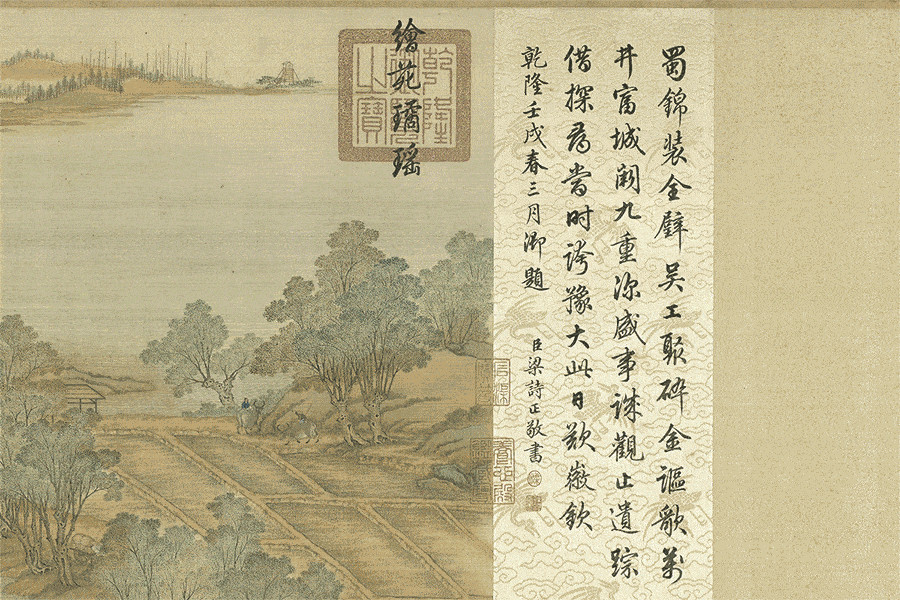
Figure 2. 张择端 Zhāng Zéduān, 清明上河圖 Along the River During the Qingming Festival, 1085–1145 CE. (click to view moving image)
In words more familiar to those of us with architectural training: parallel projection allowed 张择端 Zhāng Zéduān and other East Asian artists to create expansive, sweeping visual and spatial analyses of class, gender, geography, and daily life with great precision (Figure 2). As well, in East Asian painting traditions, text was often incorporated as poetry to heighten the experience, in this case suggesting a long journey upriver home to care for the tombs of ancestors. Earlier this year, my mother made her way home to 安徽 Anhui for the first time since 2019 to bury her father, who left us before Chinese diaspora were allowed to return,2 in time for 清明节 Qīngmíng Jié, the Tomb Sweeping Festival. All of these sweeping translations of landscape into meaning—I was taught this by my Chinese-diasporic family, but to no surprise, neither in art school nor architecture school in the US.
In Western schools, I would not ever be taught the Mandarin for parallel projection, 等距透视 děngjù tòushì, but I would learn from Chinese children’s shows after school the term, 宇宙 yǔzhòu, meaning, generally speaking, universe. Taken apart, the two words by themselves mean, respectively, “space” and “time,” because in traditional Chinese cosmology dating to 2000 years ago, the universe has always been simply space-time as one continuum. This cosmology and the representational tool of parallel projection emerged contemporaneously, informed one another greatly, and certainly might explain to us today why humans in the first century might have thought this would be a fun way to draw.
While cultures across the world have used axonometries throughout time, sixteenth and seventeenth century Jesuit missionaries expedited exchanges of East Asian parallel projection from the East to the West,3 along with silk, tea, gunpowder, paper, and spice. As historian Lisa Lowe describes, these imperial and colonial encounters were deeply and intimately connected to, and spurred, the same imperial and colonial encounters across the Atlantic in search of another route to India and China, gold, glory, and the expropriation of Indigenous and African sovereignty.4 By the time it is documented in the West by William Farish, who in 1822 writes “On Isometrical Perspective”5 to explain the utility of this representational tool in an industrializing Britain, there is no mention within his claim of authorship of any significance elsewhere, cultural or cosmological.
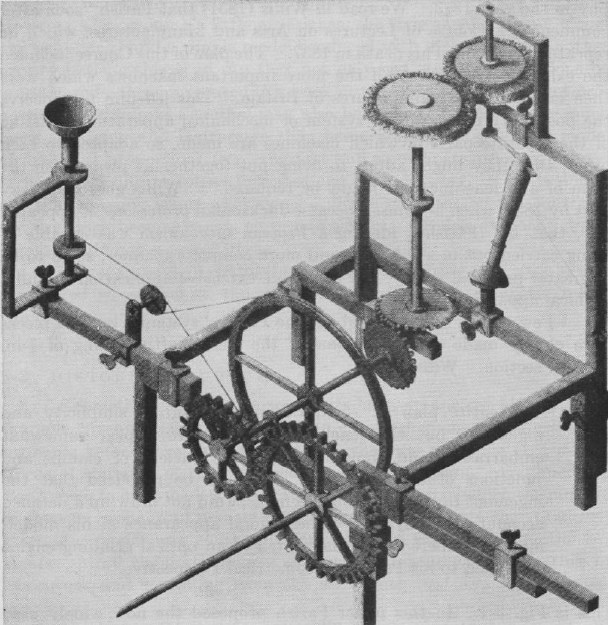
Figure 3. William Farish, optical-grinding engine model from “On Isometrical Perspective,” 1822.
In this way, drawing-as-cosmology becomes displaced over space and time into a representational tool for describing machines in service of capital (Figure 3). This isn’t to romanticize (and therefore flatten) the many origins of parallel projection, but to, in these same margins, give breathing room to the scale of how many diasporic translations of ideas have nestled up atop one another in our bodies and in the spaces we inhabit.
II.
Regardless of the project, architects create documents that facilitate translations and transitions between past, present, and future. These documents—by which I mean drawings, specifications, contracts, schedules, diagrams, photographs, and other visual artifacts—play an outsize role not only in physical construction, but in cultural construction—particularly through historical and legal records. For instance, this Sanborn Fire Insurance Map from 1919 is one of the only detailed plans of a petroleum plant design available to the public today, following the inaccessibility of both institutions (governments, industries, and their archives) and of the drawings themselves, which can be purposefully difficult to read without specialized training (Figure 4).
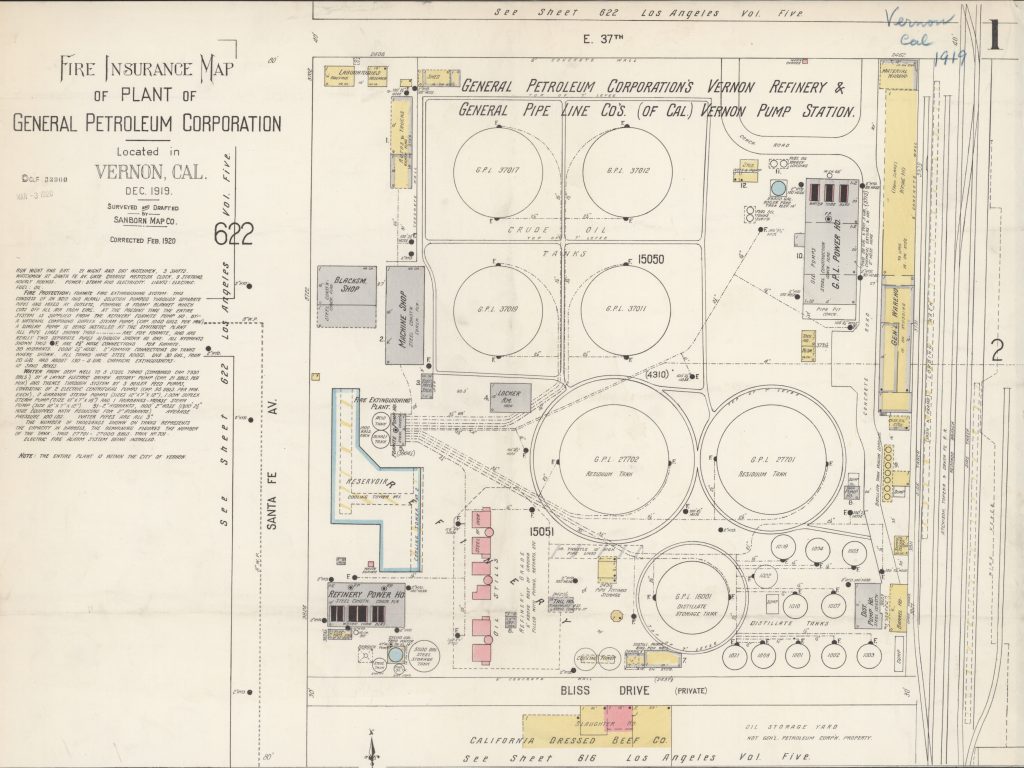
Figure 4. 1919 Sanborn Fire Insurance Map of General Petroleum Corporation, Vernon, Los Angeles County, California. Tongva lands. Library of Congress.
Significantly, this was documented, not because of educational foresight, but because of a lucrative desire to assess fire risk and thus insurance value. The ways in which this Sanborn surveyor looked at and represented this site of extraction through linework and negative space create colonial footprints, or what Cruz García and Nathalie Frankowski describe as historical narratives that, like propaganda, “satisfy the positions of settler-colonization, ruling classes, capitalism, white-supremacy, and heteropatriarchy.”6 In the case of this Spanish colonial diseño of Rancho San Pablo (present-day Contra Costa County), to “design” Ohlone and Miwok lands was quite literally to signify the boundaries of settler colonial land theft (Figure 5).
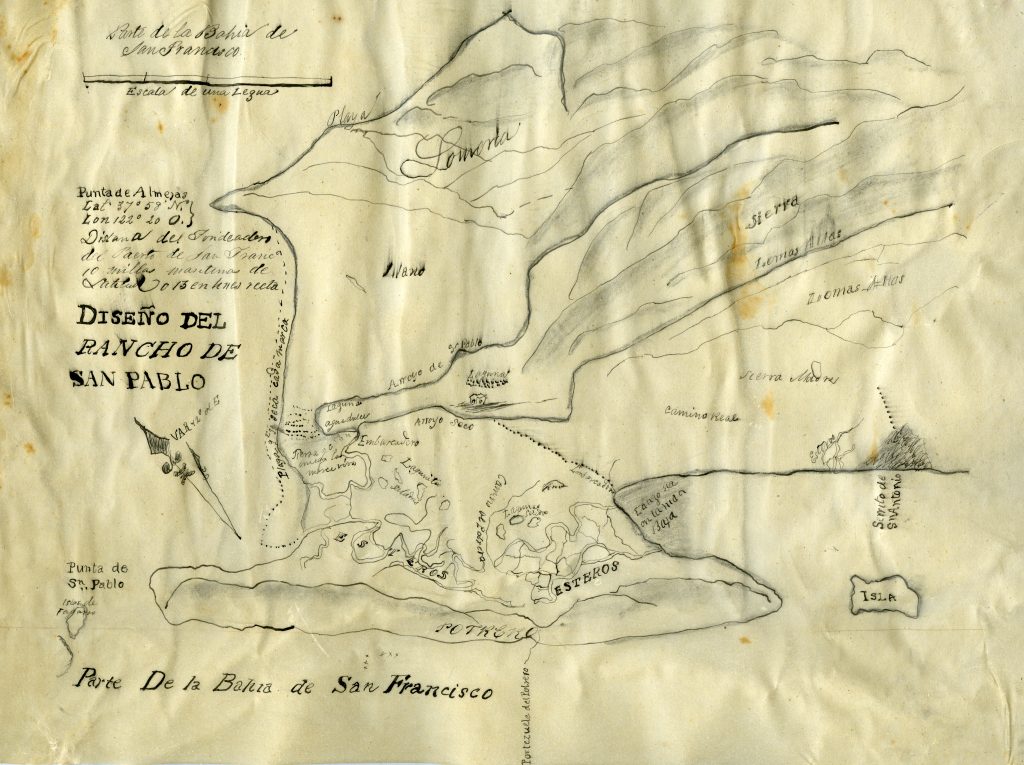
Figure 5. Former lands of Mission Delores, or San Pablo, or Cuchiosmos, or Cuchiguenos, or Cuduyunes Rancho, 1834. Ohlone and Miwok lands. California State Archives.
It is therefore both incredibly powerful and dangerous to make these documents, as unequal documentation has not only contributed to white supremacist and settler colonial structures and systems, but has perpetuated their mythologies and exacerbated their erasures. “You reproduce something by stabilizing the requirements for what you need to survive or thrive in an environment,” Sara Ahmed points out,7 as architects continue ad nauseam to reproduce certain representations and ideas of space at the expense of the possibility of others. “The more the path is used, the more the path is used.”8
Meanwhile, our experiences of global petrochemical empire are embodied in every sense: pipelines through ancestral sites, refineries along our beaches, pumpjacks on our street corners, wells across from our bedroom windows, and chemicals in our lungs. While their spatial violences are indisputably embodied, the scales, forms, and boundaries of these architectures of extraction are often intentionally obscured and thus difficult to dismantle. My practice and research thus wonder aloud about representations of violence and the violence of representations by asking questions both using and about architectural tools.
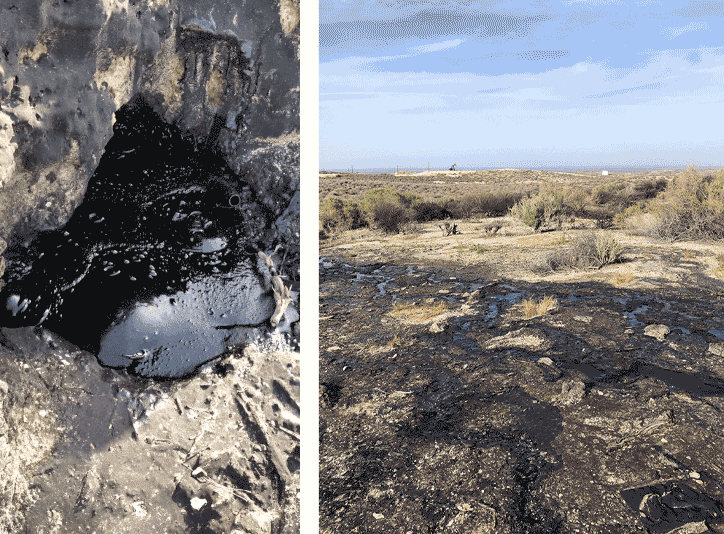
Figure 6. Photo and video of McKittrick Tar Pits in Kern County, California, Chumash and Yokuts lands. Photograph and moving image by author. (click to view moving image)
The first time I saw a real live seeping tar pit—outside Bakersfield, California, where Yokuts and Chumash communities have used tar for millennia (Figure 6)—I was so surprised at how earthly it looked and sounded and smelled and felt. I had an uncanny desire to taste it, too. It was a reminder of what Métis scholar Zoe Todd writes, that oil is kin—that these fossil former beings are not themselves harmful, but rather, “the ways that they are weaponised through petro-capitalist extraction and production turn them into settler-colonial-industrial-capitalist contaminants and pollutants.”9
Architecture’s visual strategies can be quite good at seeing and understanding entanglements at both systems and body scales. But whereas folio depictions of Western European mineral extraction in Diderot and D’Alembert’s Encyclopédie (1768) show geological details and vignettes above and below ground through sectional perspectives (Figure 7)—and even 200 years later, Standard Oil, now Chevron, itself commissioned a plan oblique for its promotional materials (Figure 8)—today, it is hard to come by representations of sites of extraction that are not stylized or abstracted from above.
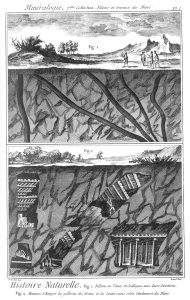
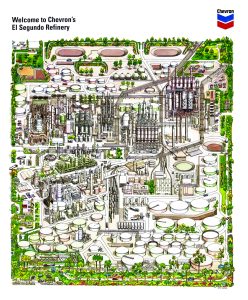
Figure 7. Diderot and D’Alembert, “Mineral Lodes or Veins and their Bearings,” from Encylopédie, vol. 6, 1768; Figure 8. Chevron promotional booklet, undated ca. 1970. Tongva lands. El Segundo Historical Society.
I started making my own drawings of oil landscapes—crude representations, if you will—because in researching sites of extraction and resistance, I regularly found that most existing representations (architectural and otherwise) are neither accurate nor precise about adjacencies, and thus could not become accurate or precise about their impacts. When oil infrastructures are adjacent to our homes and communities (as they always are at some scale), these documents tend to not include both places at once—or to otherwise misrepresent spatial violence. For instance, an image search for Point Molate Beach and the adjacent Chevron refinery in Richmond, California yield photo-narratives of place that seem worlds apart—and yet these two places are only imagined as separate but are really one petrochemical landscape.
As Richmond organizers and residents fighting environmental injustice can attest,10 this is a harrowing and dangerous oversight with extreme harms done to communities and ecosystems. Since the 1990s, along with Communities for a Better Environment (CBE) and other environmental justice organizations, the Asian Pacific Environmental Network (APEN) has organized refugee and immigrant communities, primarily Laotian and Southeast Asian, against environmental health violations committed by Chevron and their agents. Confronted with what Nicholas Mirzoeff describes as “complexes of visuality,” which visualize history to enable claims to authority,11 I follow the work of radical thinkers and organizers like APEN and CBE in trying to exercise a right to look—and the right to visualize our own histories.
One of my most recent works, Crude Neighbors: Chevron Refinery, Richmond California, is a 36-by-36-inch acrylic on canvas painting of the refinery in Richmond, on Ohlone and Miwok lands, the first refinery built by Standard Oil in California (Figure 9). Although, insofar as acrylic paint is a petroleum product, I’ve started to more truthfully refer to it as an “oil painting.” The work is set to a scale, meaning every one inch represents 250 feet, and it employs axonometry, in this case, oblique parallel projection, historically an East Asian landscape painting technique, later co-opted by Western architecture for military and industrial use. If it sounds a bit convoluted to create a landscape painting at an engineering scale in a projection that comes from both Chinese art and Western architecture, it is perhaps in that messiness that I seek some kind of clarity.
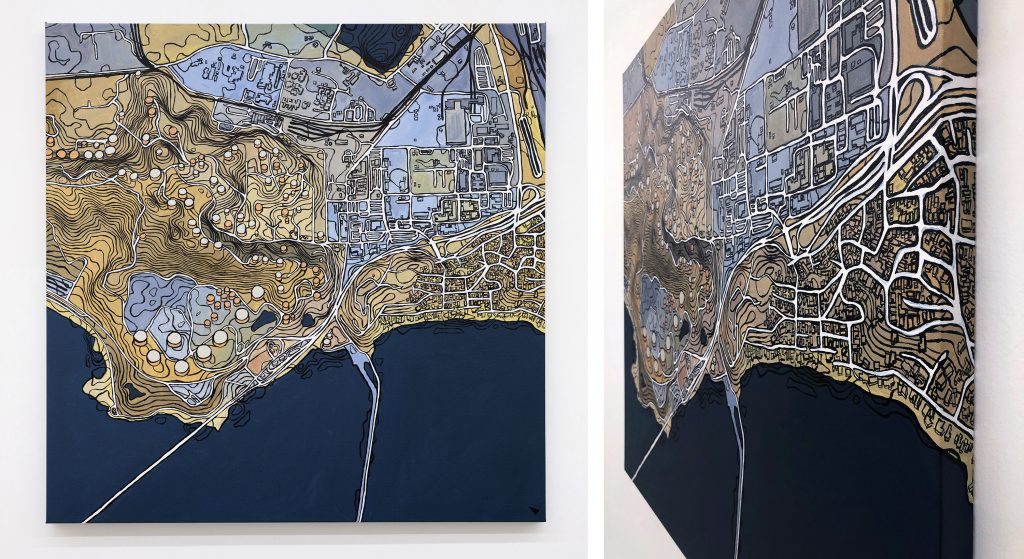 CalArts REEF Artist-in-Residence in downtown Los Angeles. Tense Renderings
CalArts REEF Artist-in-Residence in downtown Los Angeles. Tense Renderings
Figure 9. Bz Zhang, Crude Neighbors: Chevron Refinery, Richmond, California. Acrylic on canvas, 36 x 36 inches, 2022. Ohlone and Miwok lands.
I could make this painting by translating and projecting two- and three-dimensional data, integrated from publicly available sources like OpenStreetMap, NASA, the US Geological Survey, and so forth. These tools of architecture can approximate real-world spatial conditions with remarkable precision, so that we see representations of buildings and freeways and railways and the contours of the land. However, this precision is only as good as the data we put in. Whereas publicly available sources attempt to give us the reality of built structures, they do not (and could not) show us everything. As designers (from the Latin designare, to designate), we strive to represent the stories and spaces that interest us and fail to represent those that do not. Oil infrastructures, or the spatial typologies of what Neeraj Bhatia describes as the “surfaces, containers, and conduits” running through our cities and landscapes,12 so often do not. Although seen from above in satellite imagery, these oil infrastructures are conspicuously absent in publicly available linework, which turns out to not be accurate at all (Figure 10).
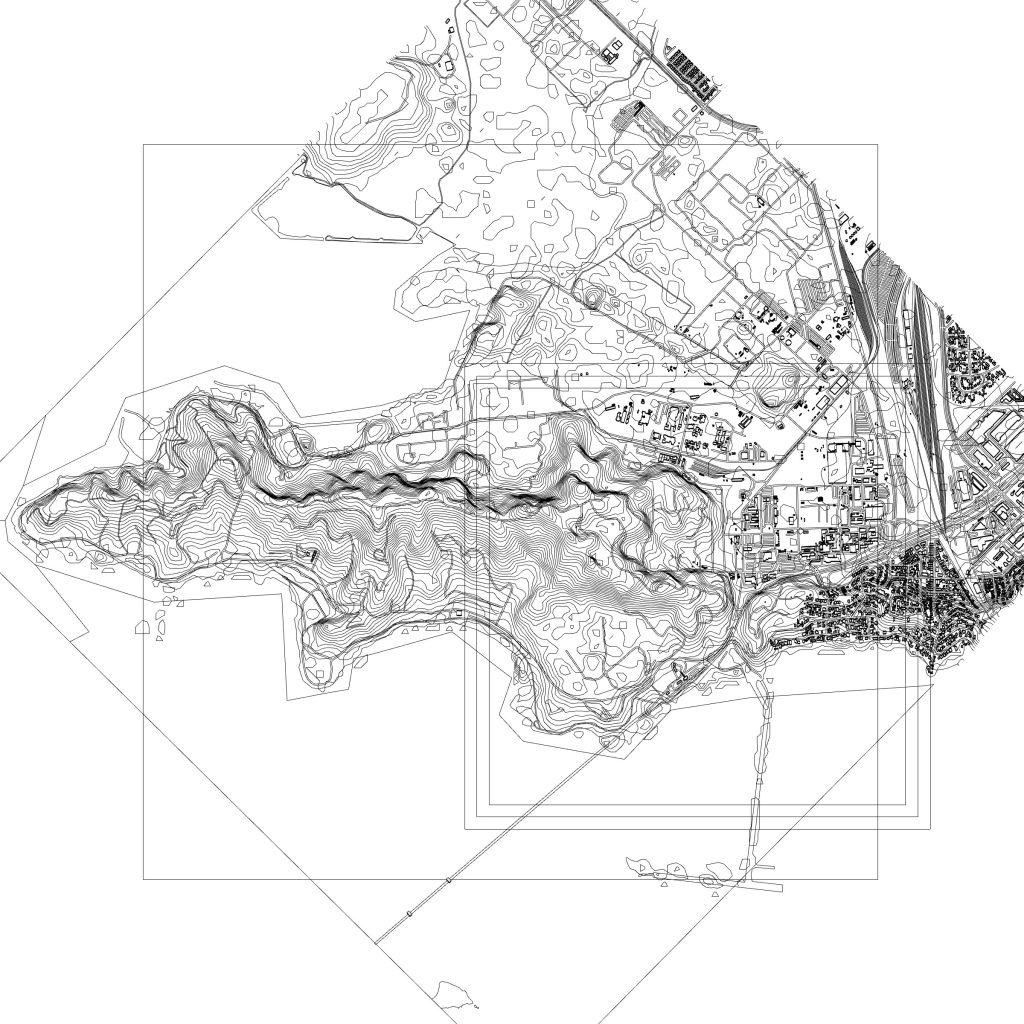
Figure 10. Bz Zhang, Crude Representation(s): Chevron Refinery, Richmond, California, 2022. Layers of linework compiled by author using OpenStreetMaps, NASA, and US Geological Survey files representing Richmond, California, Ohlone and Miwok lands.
Today, this satellite image is usually how we, the public, would see sites of extraction (Figure 11), and this bird’s eye, which itself has roots as a military technology, distorts our relationship to them, hindering our understanding of how they work and the types of spatial violence they may be inflicting. This refinery in particular is notorious for toxic gas flares, spills in the San Francisco Bay, and even explosions.
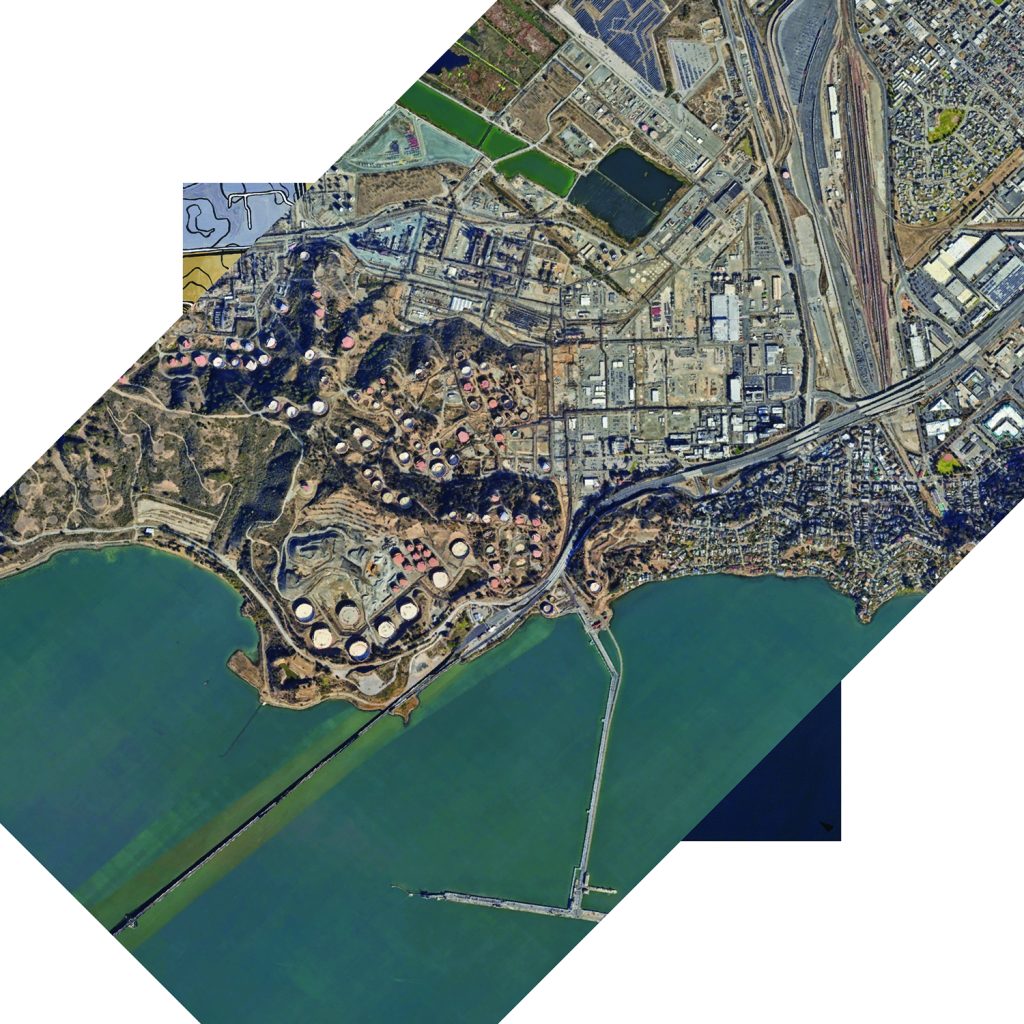
Figure 11. Bz Zhang, Crude Representation(s): Chevron Refinery, Richmond, California, 2022. Acrylic painting behind 2022 Google Maps satellite image of Richmond, California, Ohlone and Miwok lands.
We think of architectural linework or satellite imagery as more technologically advanced and thus more accurate, while we assume paintings, for instance, are not. Perhaps this is mostly the case, but when we see blank gray fills instead of oil infrastructures in municipal zoning maps, with which the city of Richmond determines lawful land use, it becomes clear that something huge has been missed in the accuracy of its visual representation and its accountability to the public.
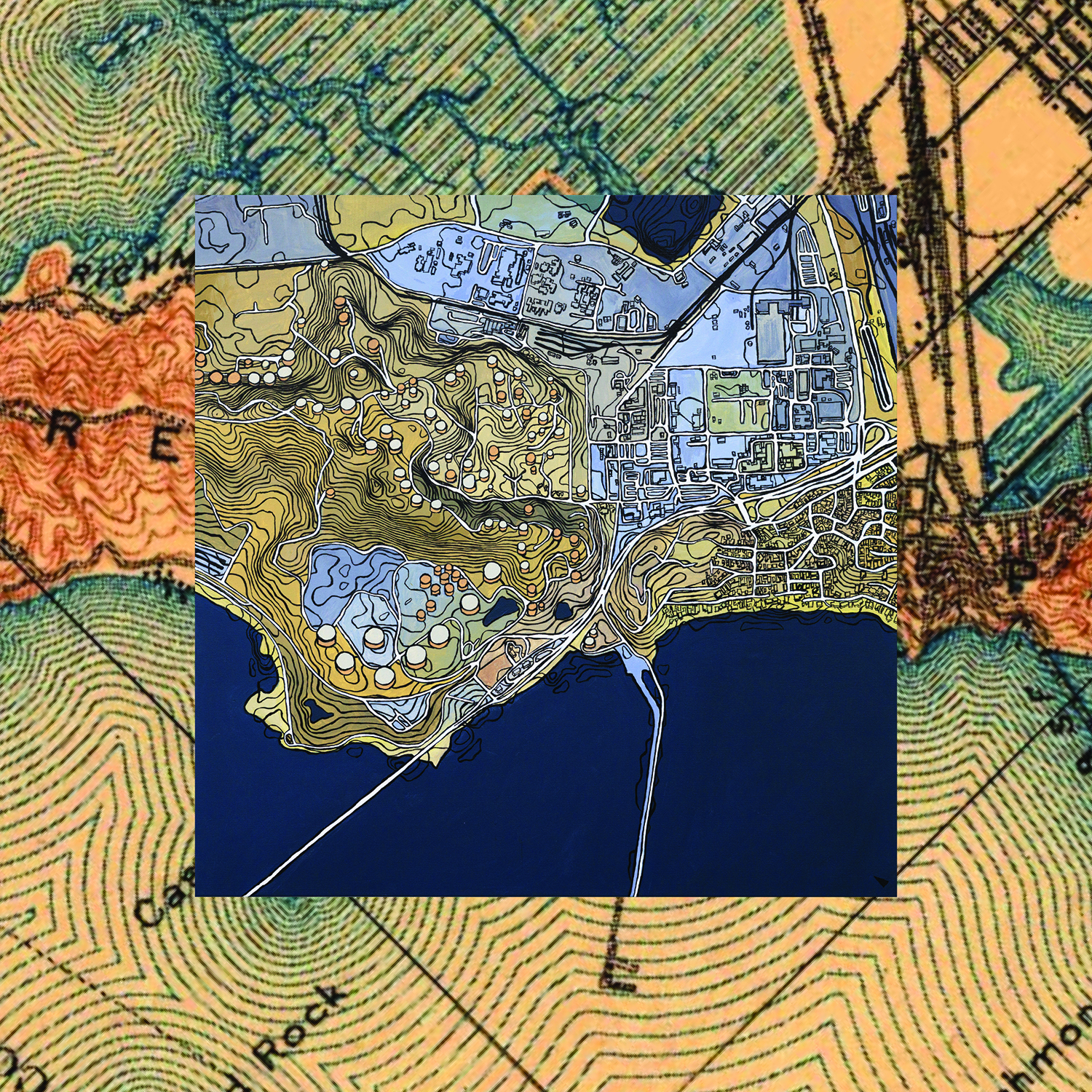
Figure 12. Bz Zhang, Crude Representation(s): Chevron Refinery, Richmond, California, 2022. Acrylic painting framed by 1915 US Geological Survey map of Richmond, California, Ohlone and Miwok lands.
In the first US Geological Survey map of Richmond in 1895, we can see that what was once wetland ecosystems in kinship with Ohlone communities is today an infilled network of pipes, railways, tanks, boilers, and tailing ponds. On the edge of a subsequent 1915 geological survey (Figure 12), we can see that Point Molate was actually the site of a Chinese shrimping village, one of dozens found across the San Francisco Bay between the late nineteenth and early twentieth centuries, from Richmond to West Oakland to Marin to Hunters Point, of which only one exists today. And, having been founded in 1902, we can also already see Standard Oil’s pier, from which Chevron still today receives oil tankers.
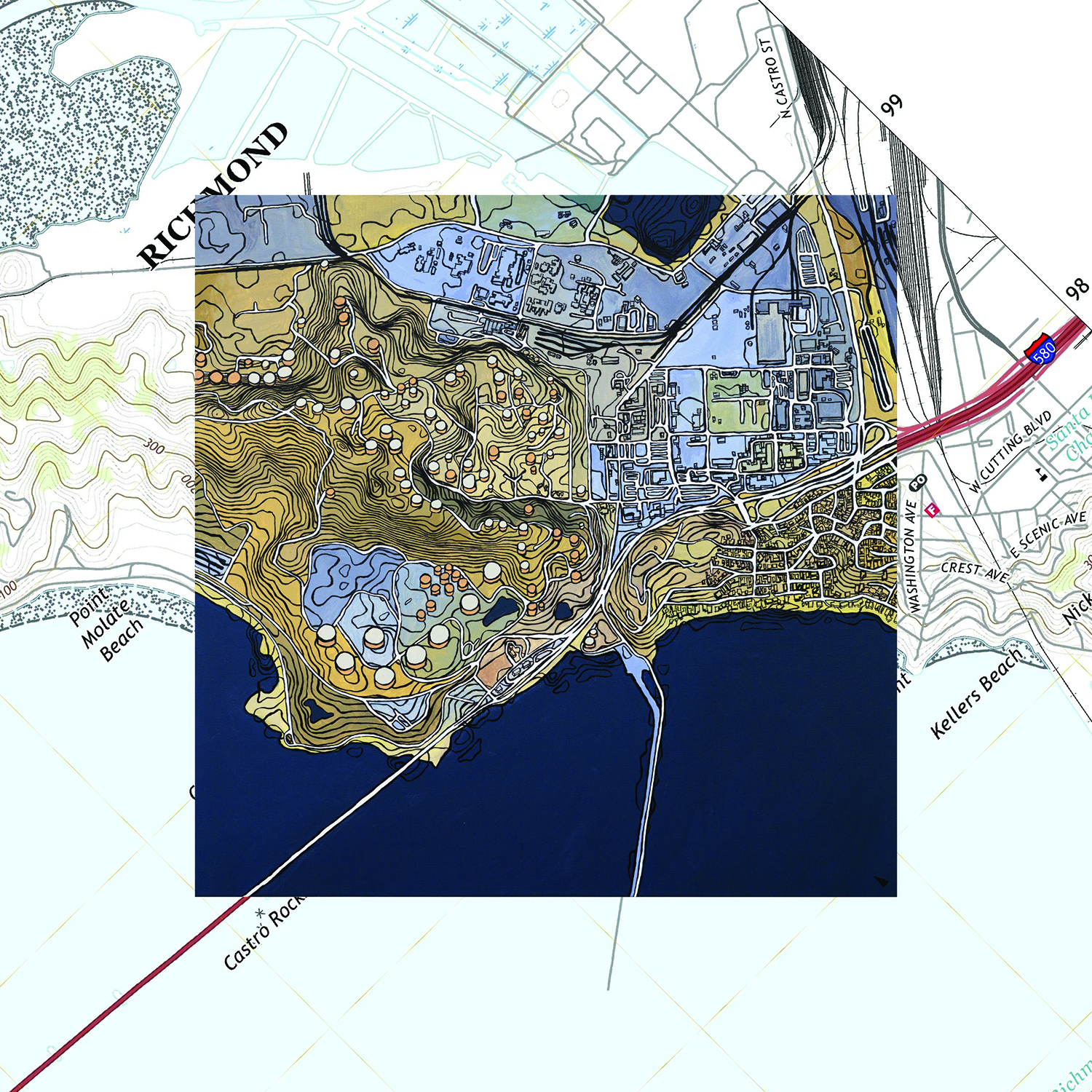
Figure 13. Bz Zhang, Crude Representation(s): Chevron Refinery, Richmond, California, 2022. Acrylic painting framed by 2021 US Geological Survey map of Richmond, California, Ohlone and Miwok lands.
Only the pier remains visible in the most recent publicly available USGS map of Richmond, from 2021, which uses the same pale blue fill to code both toxic tailing ponds in the refinery yard at the top of the image and the San Francisco Bay water on the bottom and omits any other markings that would indicate the presence of oil (Figure 13). But most of us are not looking at maps by the USGS to move through the world. Most days, we might all be looking at one particular map from Alphabet, which applies the same representational logic. Just as freeways on Google Maps are flattened to approximate surface roads, which softens our perception of their violent past and present, oil infrastructures melt into soft grays and blues, as if they weren’t even there.

Figure 14. Bz Zhang, Crude Representation(s): Chevron Refinery, Richmond, California, 2022. Acrylic painting framed by maps of Richmond, California, Ohlone and Miwok lands: 1895 US Geological Survey, 1915 US Geological Survey, 2016 municipal zoning map, 2021 US Geological Survey, 2022 Google Maps. (click to view moving image)
Across time and space, these strategies for obscuring complex systems are, as we know, by design (Figure 14). At the core—and often contractually—we reproduce systems of oppression by stabilizing them in documents through claims of neutrality, through our omissions, our complicitness, through our carelessness. As reported by Stand.earth and Amazon Watch, half of the Amazonian crude oil extracted and exported from Ecuador, where Chevron famously was sued over an oil spill in 2011, comes to California.13 With the San Francisco Bay and Los Angeles as critical nodes, the flows of oil and capital crisscross borders and oceans, creating a continuous oil landscape and continuous frontline.
But tools come from many space-times and can be used in many other ways. As Macarena Gómez-Barris has described, we can “utiliz[e] the same technologies of research and digital output that corporations use [and yet] divert and repurpos[e] them to deauthorize the extractive view.”14 In disentangling representational tools of Western art and architecture—the so-called “master’s tools”—from what Audre Lorde terms “the master’s concerns,”15 I am following practices of Indigenous, Black, and decolonial countervisualities, from collective mapping by the Native Lands Advocacy Project, the Watch the Line Project made by coalitions to Stop Line 3, to Imani Jacqueline Brown’s Unraveling Industry: Follow the Oil project mapping petrochemical landscapes in Louisiana. In particular, I look to the trans and nonbinary and queer and woman and disabled and worker futurities within them that have each distinctly and collectively resisted extractivism of lands and bodies for centuries.
III.
While Crude Neighbors, the “oil painting,” was being exhibited in Los Angeles,16 I was driving to an artist residency halfway across the continental US and stopping by more sites of extraction along the way: the Hoover Dam bisecting the Colorado River in Nüwüwü and Hualapai lands; silver and gold and copper and salt mines across California, Nevada, Utah, and into Colorado. In doing so, I followed the waters stolen every day by the Los Angeles Department of Water and Power up to their source in Colorado, and I tumbled down the other side into the Mississippi River watershed, where the South Platte River led me to my new temporary home.
But curious things had been happening for a while. The year before, while accompanying Mexican-American and French-Tunisian artist Red Rotkopf in his research and photography on California settler colonialism, we turned a corner from the Misión de Santa Bárbara, on Chumash lands, and found ourselves unexpectedly in front of a cocktail bar, still wearing its first name, “Jimmy’s Oriental Gardens,” in an old Chinatown I’d never heard of. Another time, at an abandoned borax mine in Death Valley, Western Shoshone lands, I squinted to see the unmarked ruins of housing for Chinese laborers in the flats below, which had been noted only in passing on the interpretative sign. Now, in Denver—Cheyenne, Arapaho, Ute, and Oceti Sakowin lands—where I stopped to eat banh mi at my sister’s favorite spot, I visited the wall downtown where a plaque had just been removed because of its racist and derogatory language placing blame on Chinese residents for the 1880 race riot carried out against them (Figure 15).
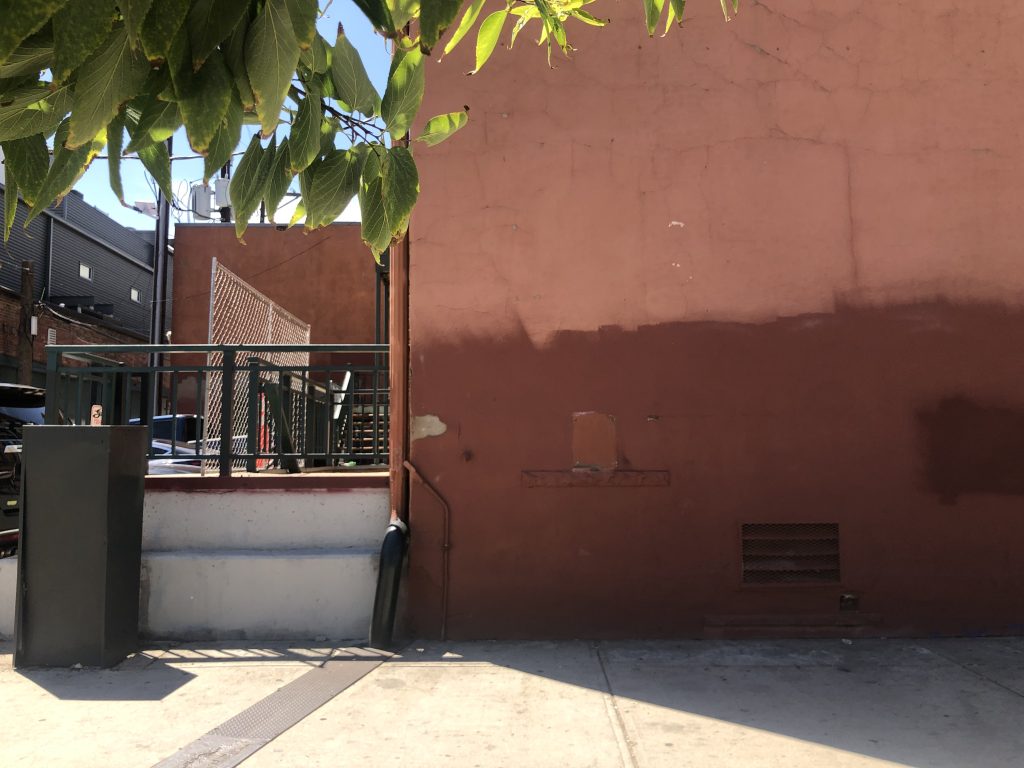
Figure 15. Location of former plaque memorializing the so-called “1880 Chinese Riot,” which was an anti-Chinese race riot instigated by white residents of Denver, Colorado, on Cheyenne, Arapaho, Ute, and Oceti Sakowin lands. The white mob of about 3,000 burned down Chinatown, killed one Chinese man, and wounded others. None were held accountable. It is not a coincidence that the removal of the plaque and official apology has been overseen by Mayor Michael Hancock, Denver’s second Black mayor. Photograph by author.
The message I read on this wall was: There is a body (mine), looking.
In her book Ornamentalism, Anne Anlin Cheng offers a feminist theory for the “yellow woman,” whose peculiar experiences both intersect with and depart from other racialized and gendered subjectivities surviving between personhood and objecthood. To survive in Western, white supremacist spaces in a body that is Asian and femme is to be “[s]imultaneously consecrated and desecrated as an inherently aesthetic object.”17 It is from this vantage point that I have been sitting with a set of Chinese phrases, permeating across the Pacific since our first encounters with Westerners: 丢脸 diūliǎn, to lose face; 保全面子 bǎoquán miànzi, to save face; 给面子 gěimiànzi, to give face; even 要 yào or 不要脸 bùyào liǎn, to want or to not want face. There are at least a dozen other turns of phrase describing the demonstration of respect, deference, or the failure thereof, and even a line in Alice Wu’s iconic queer Asian film, “Saving Face,” from 2004, in which father says to daughter, “我这辈子的脸被你都丢光了 Wǒ zhè bèizi de liǎn bèi nǐ dōu diū guāngle! You have lost me my entire lifetime’s worth of face!”18
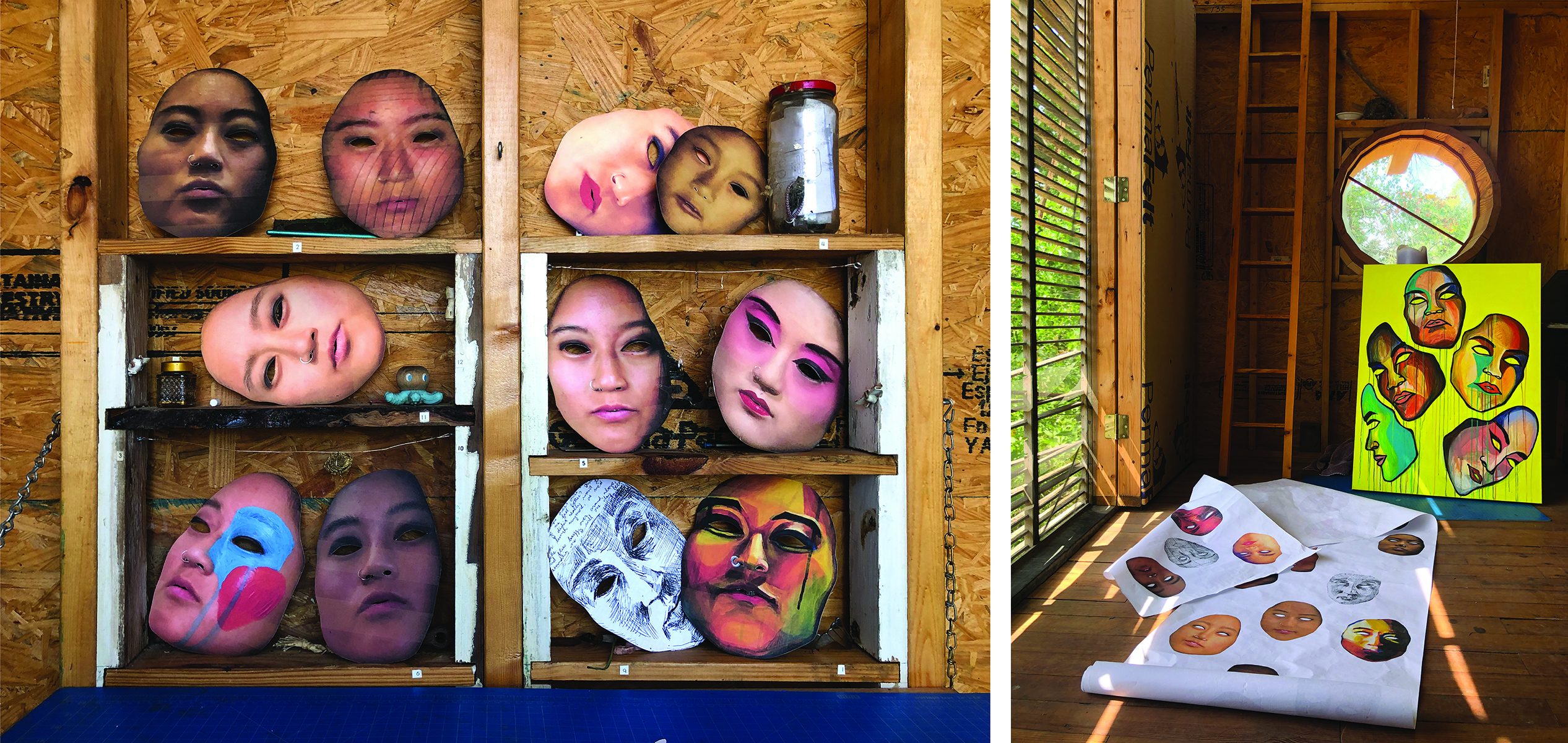
Figure 16. Details from Bz Zhang, 丢脸 diūliǎn / lose face series while artist-in-residence at Art Farm (Marquette, Nebraska), 2022. Oceti Sakowin and Pawnee lands. Photographs by author.
In Nebraska, Oceti Sakowin and Pawnee lands, I worked from this focal point in hopes of physically, culturally, and emotionally excavating experiences of shame, dysphoria, agency, and identity through a queer trans Chinese-diasporic lens, by literalizing these actions taken upon a face (Figure 16). Particularly through the eyes of this “yellow woman,” who lives within my body even as I do not self-identify as yellow nor woman, I asked: Who owns a face, whose is it to lose or to save, and where has it gone when lost? As “someone too aestheticized to suffer injury but so aestheticized that she invites injury,”19 how does one—borrowing from trans and queer Black and Brown ballroom culture—serve one’s own face instead?
By chance, this artist residency was a stone’s throw away from the eastern terminus of the first transcontinental railroad in the United States, in Council Bluffs, Iowa, which I visited dutifully, and by chance, I had planned to drive along I-80 to my next engagement, at the western terminus in Gauh Gāmsāan (旧金山, Jiùjīnshān, San Francisco). Tracing this route, I left paper masks—lost my faces—one by one at sites of Chinese diasporic settlement. I was traveling forwards on the colonizer trail to California and yet meeting the ghosts of my ancestor-cousins living and working and inevitably loving themselves and others inland, and thus somehow I was going forwards and backwards at the same time (Figure 17).
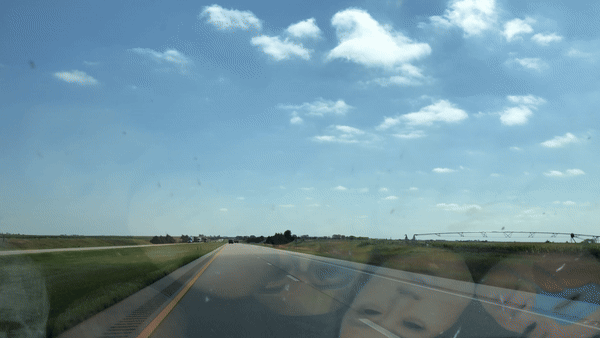
Figure 17. Details from Bz Zhang, 丢脸 diūliǎn / lose face series while artist-in-residence at Art Farm (Marquette, Nebraska), 2022. Oceti Sakowin and Pawnee lands. Moving image by author. (click to view moving image)
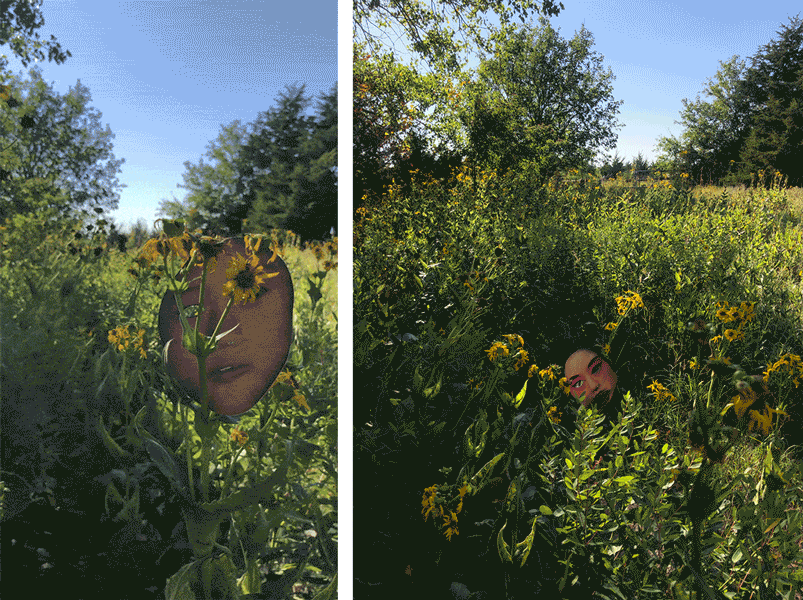
Figure 18. Details from Bz Zhang, 丢脸 diūliǎn / lose face series while artist-in-residence at Art Farm (Marquette, Nebraska), 2022. Oceti Sakowin and Pawnee lands. Photograph and moving image by author.
It finally occurred to me that in my makeshift procession along this haunted infrastructure, I had not been losing my face in all those gestures, but perhaps giving it to—meaning to show due respect for—ancestor-cousins of mine along the railway (Figure 18). The faces aside, I was still looking for more sites of extraction hidden in the Sanborn Fire Insurance Maps when I stumbled across one word a dozen times, then a dozen more, and more again: “Chinese,” a word which looks and sounds nothing like our many words for ourselves—scrawled across maps made by an Anglo-American company to finesse capital out of fire. These maps are well-known to architects as a time capsule of nineteenth and twentieth century US cities and towns for our reference, but they were in fact created by and for Anglo-Americans to sell fire insurance policies from urban centers based on a surveyor’s assessment of hazard. And while these maps were never made with non-white communities in mind, nor for their safety, nor their participation, at site after site of nineteenth century extraction, I found traces of Chinese diaspora in handwritten capitalized letters.
The sites I was now tracing had been inscribed and reinscribed into land by a succession of US white settler colonial infrastructures: the California Trail (established 1811–1840), the First Transcontinental Railroad (constructed 1862–1869)—which exploited Chinese bodies and labor to dispossess Indigenous peoples and lands and to suppress Black resistance and liberation20—and finally, Interstate 80 (constructed 1956–1986). Their sequence was, incidentally, traced again in 1988 by recently arrived Chinese students, my parents in the Beautiful Country (美国 Měiguó USA), and, suddenly, in 2022, by me, searching.
Looking and searching became 给面子 gěimiànzi—giving face—to Chinese-diasporic informal architectures across the continental US, outside of all the major cities where we’d expect them. In some cases, there is one remaining building—such as in Truckee, California, where Chinatown was destroyed three times, and the last remaining building, an herbal store, is now an office for an interior design firm—or perhaps a reconstructed facsimile as a museum, as in China Camp State Park, where I was sharing the view with a white wedding party in Marin County. In others, there is just one street sign—as in “Plum Alley” outside of a parking garage in Salt Lake City, Utah, or “Ahsay Avenue” named for a Southern Chinese labor organizer in Rock Springs, Wyoming (Figure 19). While I ran out of paper masks of my own face to leave behind, I continued taking with me photographs on my phone, oriented and cropped as if documenting progress on a job site. Truthfully, these are ongoing sites of construction. As bell hooks wrote of Black cultural genealogies of resistance, “the vernacular is as relevant as any other form of architectural practice.”21 Up and down Main Street in Lohk gēui jan (樂居鎮, Lèjūzhèn, Locke, California) in Sacramento County, the largest surviving rural Chinatown, the material histories of the “vernacular” (and its historic preservation or lack thereof) speak plainly of cultural legacies, politics of land ownership, and the coevolution of multiethnic communities.
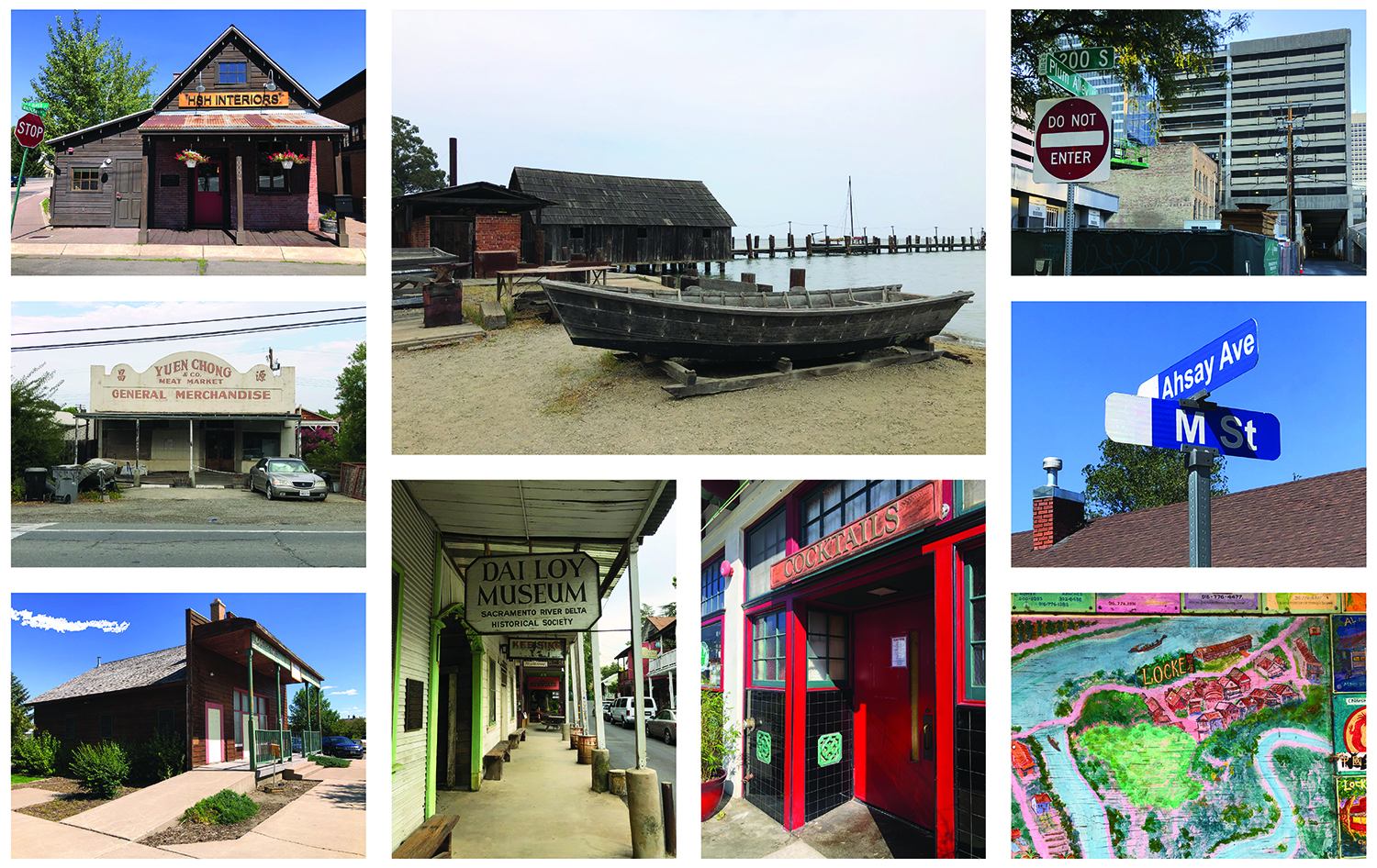
Figure 19. Clockwise from top left: Truckee, California, Washoe lands; Marin County, California, Coast Miwok lands; Salt Lake City, Utah, Eastern Shoshone and Goshute lands; Rock Springs, Wyoming, Eastern Shoshone and Cheyenne lands; Walnut Grove, California, Lisjan Ohlone and Plains Miwok lands; Santa Barbara, California, Chumash lands; Locke, California, Lisjan Ohlone and Plains Miwok lands; Evanston, Wyoming, Eastern Shoshone lands; Locke, California, Lisjan Ohlone and Plains Miwok land. Photographs by author.
But in nearly all cases of rural Chinese diaspora in the US West, Chinatown was purposefully set on fire and burned to the ground, as in Reno, Nevada, where it was burned down at least twice, the second time by the Reno government (Figures 20 and 21). Locke was only founded after the Chinatown of nearby Walnut Grove was consumed by flames in 1915. And so, in nearly all cases of Chinatown burned to the ground, I continue to look for and find traces of us in the insurance maps they drew in case of fire.
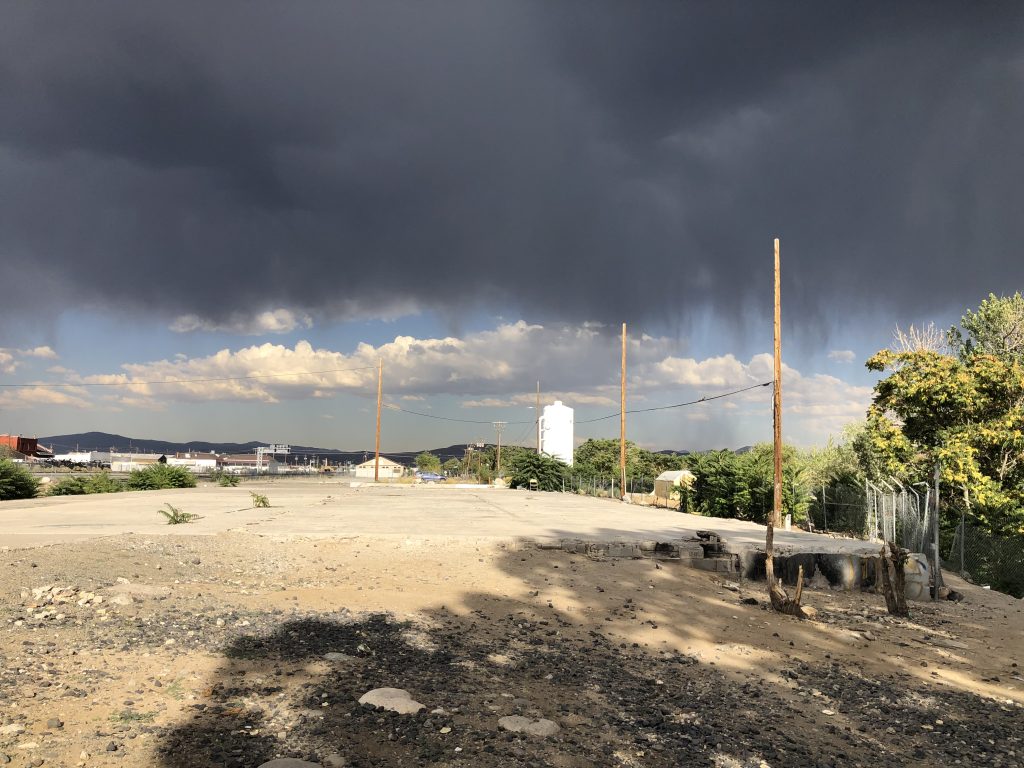
Figure 20. Ruins of Chinatown in Reno, Nevada, 2022. Washoe and Northern Paiute lands. Photograph by author.
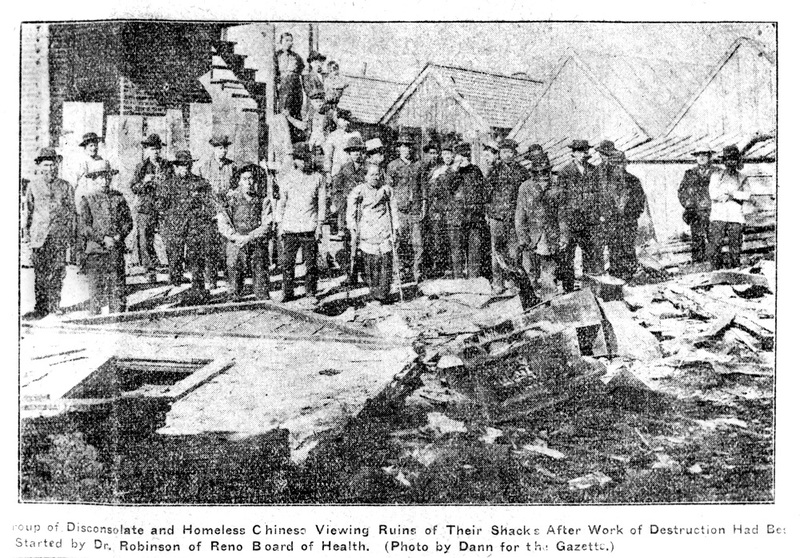
Figure 21. Ruins of Chinatown in Reno, Nevada, 1908. Washoe and Northern Paiute lands.
In engaging Sanborn maps, which most often labeled Chinese structures as hazards, as seen in the green highlight of Chinese-owned laundries in San Rafael, California, I used translation to reconstitute Chinese diasporic structures—or, in truth, a phantom or shadow of them—out of the technical details left by Anglo-American surveyors: 1-story or 2-story; stove pipes or terracotta or brick chimneys; composite or shingled roofs, fire walls, and so forth (Figure 22). There are virtually no other architectural documents of these Chinese diasporic settlements, and yet, translating what is on the page only reveals the limits of translation, in what truths are not there.

Figure 22. Giving face to ancestor-cousins in 1887 Sanborn map of San Rafael, California, Coast Miwok lands. Animated image by author.
These architectural pasts and presents reflect the calculus of white supremacist settler colonization in time and space—on the one hand, “The Chinese Must Go!” (a rallying cry originating in the 1870s in California, in many ways the birthplace of anti-Asian racism in the US); and on the other, instances of their forced enclosure, when, for example, the US Federal Army was stationed in Rock Springs, Wyoming for fourteen years, following the 1885 Chinese Massacre, in order to prevent Chinese miners employed by the Union Pacific from escaping white racial violence (Figure 23). As Tao Leigh Goffe has written about enslaved African, indentured Asian, and racialized peoples across empires, “in the historical ledger barely a trace of these subjects’ intimate, interior lives is recorded,”22 and thus we must utilize interdisciplinary, subversive strategies and draw upon our converging histories and intellectual traditions to see them.
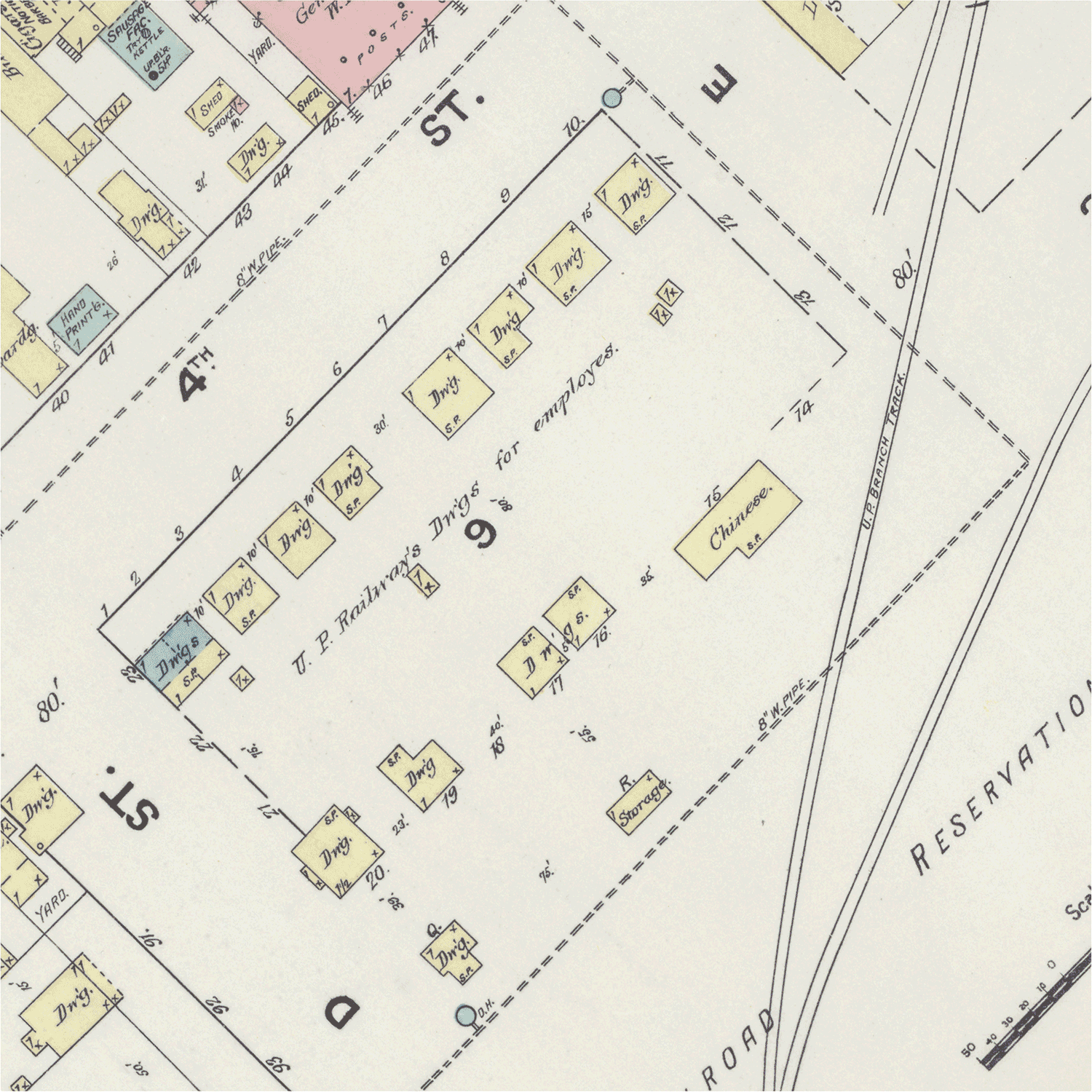
Figure 23. Giving face to ancestor-cousins in 1890 Sanborn map of Rock Springs, Wyoming, Eastern Shoshone and Cheyenne lands. Animated image by author.
Back in Los Angeles, I worked with artist and bookmaker Taylor Zanke of Allowing Many Forms to produce an artist book, titled In Case of Fire 万一火灾,23 which could attempt to make visible what is missing from the archives while giving face to the people who endured horrific violence and yet were more than those experiences (Figure 24). I was guided by brilliant artists and scholars in sifting through archival photographs and my own photos to register narratives across time, following methodologies of Mitchell Squire’s portraiture and performance, Saidiya Hartman’s speculative histories,24 Katherine McKittrick’s critical geographies,25 the Chinese diaspora archeologies of Kelly N. Fong 方少芳, Laura W. Ng 伍穎華, Jocelyn Lee 李紫瑄, Veronica L. Peterson 孫美華, and Barbara L. Voss,26 and what Édouard Glissant termed le droit à l’opacité, or the right to opacity.27
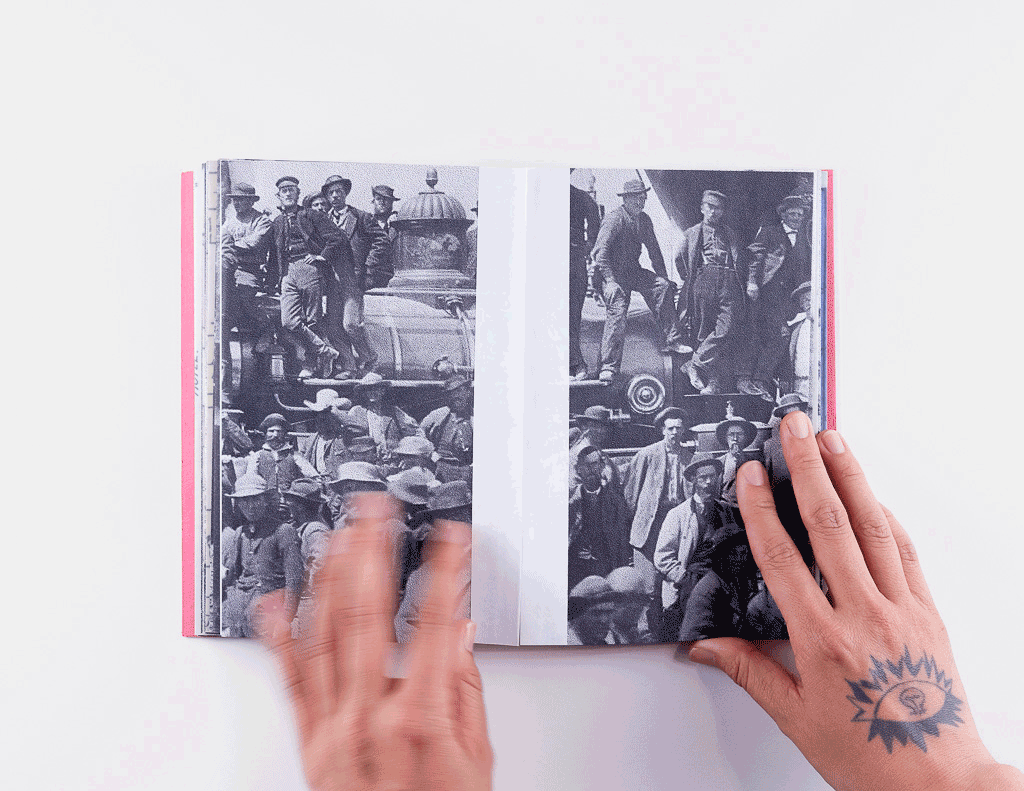
Figure 24. Details from Bz Zhang, In Case of Fire 万一火灾, handmade artist book, created while artist-in-residence at Allowing Many Forms (Los Angeles, CA), 2022. Photographs by Allowing Many Forms. (click to view moving image)
I found that by directly situating original source materials, rather than translating each archival and contemporary photograph into architectural drawings and documents, I could register more than spaces across time: I could in fact register a Chinese-diasporic gaze (mine) to both spaces and other gazes (most often, white and cis and male). At most of these sites, I had a choice of whether to include violent images and texts, and whether certain translations ought not to be made, and whether other translations might 给面子 gěimiànzi instead, to properly see these lives lived in wholeness.
As well, hegemonic narratives of Chinese diaspora in the Americas continue to disregard (or are unable to comprehend) experiences that are not cis and male. As Fong et al. write, “historic censuses list few Chinese American women and children… but family histories and missionary records describe diverse households, including intergenerational households, heterosexual nuclear families, single parents, and single-gender households.”28 I follow writers Patricia Powell, in The Pagoda, and, more recently, C. Pam Zhang, in How Much of These Hills is Gold, in wondering aloud: if even one Chinese-diasporic person assigned female at birth was there, I want us to look for them.
IV.
I have passed countless hours in the last years with Sanborn Fire Insurance Maps, most frequently peering at digital reproductions through computer screens and scanning page-by-page for oil wells, refineries, coal mines, and then work camps, rail stations, lumber yards, and then Chinese laundries, “shanties,” and the words “female boarding” designating places of sex work. The time moves slowly. The cautious excitement of finding precious traces turns sour with the repetition of the archive’s callous disinterest—the word “C H I N E S E” stretched across entire neighborhood blocks without further detail—and I remind myself often to sit up straighter.
One day, I found a phrase I hadn’t yet seen before, scrawled on a 1904 Sanborn map of Reno, Nevada (the Chinatown had already been burned down once, in 1878, and would be burned down again four years later): “Chinese vegetable garden” (Figure 25).
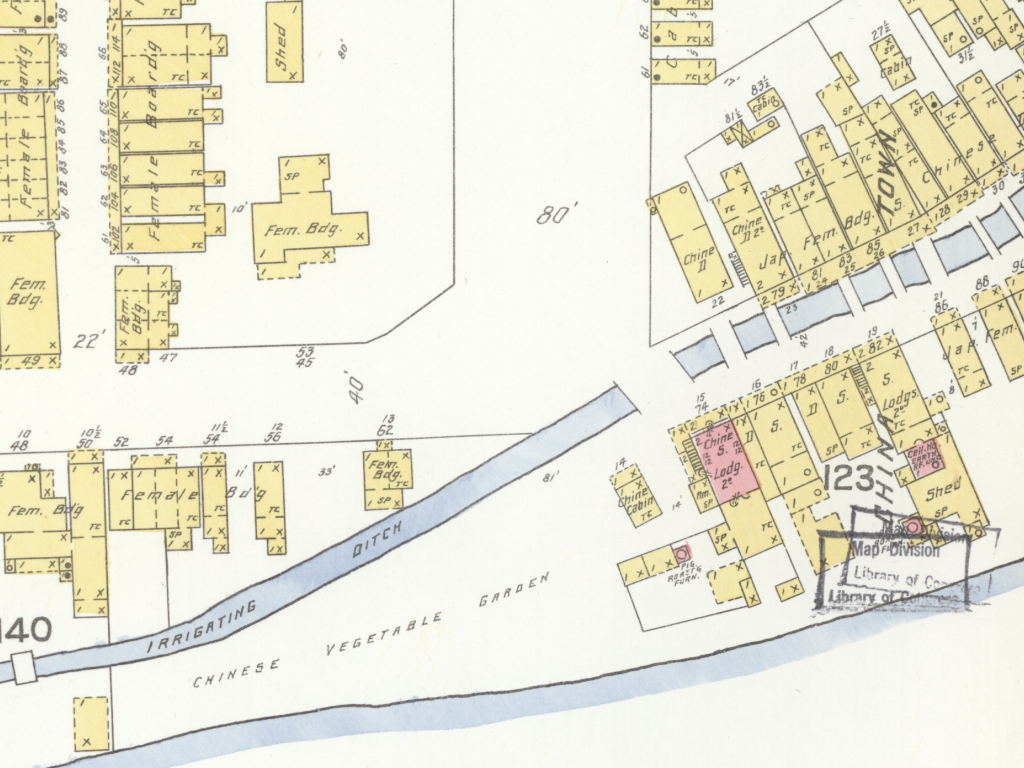
Figure 25. Detail from Sanborn Fire Insurance Map, Reno, Nevada, 1904. Washoe and Northern Paiute lands. Library of Congress.
I unexpectedly cried upon reading those three words. I looked up from my desk involuntarily, as if to register whether anyone else (any other gaze) had seen it, too. I felt I needed to know who had written those words: was he—it was almost certainly “he”—struck by the garden’s size, its abundance, its smells, its sounds of Hakka, Toisan, Cantonese words and laughter? Was he disgusted; did he consider it a nuisance, a hazard to be documented; did he see the gardeners as human? Did he speak with them, the ways I wish I could? Elsewhere, scholars have documented cultural exchanges between Chinese and Shoshone, Paiute, Ute, and other Indigenous peoples, including the sharing of baahk choi (白菜, báicài, bok choy) and medicinal herbs,29 as well as the dependence of white Anglo-Americans on Chinese cooks and gardeners for survival in the West.30 I wasn’t necessarily uncovering something for the first or even the hundredth time, but I felt I had, in looking from this body, caught and held momentarily, across 100 years, the gaze of another body, looking at my ancestor-cousins and writing, by hand, those three words.
I don’t know that we can know the exact circumstances for how the words “Chinese vegetable garden” made it onto this fire insurance map, nor the dreams held by those who planted seeds within it. But on her way back from her own father’s funeral, my mother brought me seeds from our ancestral village in 安徽 Anhui and planted them for me in my backyard in 洛杉矶 Luòshānjī, Los Angeles. Without missing a beat, she harvested long stalks of bamboo, serving only as ornamental hedging in the moment before, and improvised a trellis for those vines to grow.
In an instant, she and I became bodies (ours), looking, from within an ocean of generations who have tended to choi yùhn (菜園 càiyuán, vegetable gardens)—diasporic translations of ourselves, our memories, and our communities as seeds passed through hands and earth and sea and sky, carried across unfurling scrolls of space and time.
Bz Zhang 张迪 (they/them) is an architect and artist based on unceded Tongva land (so-called Los Angeles) using disciplinary tools of architecture to imagine futures beyond settler colonialism, racial capitalism, and cisheteropatriarchy. They organize with Dark Matter U, the Design As Protest Collective, and the Los Angeles Neighborhood Land Trust. Zhang is a 2022 Journal of Architectural Education Fellow, 2021 USC Citizen Architect Fellow, and a licensed architect in California. As a design professional, they have learned from and worked alongside contractors and fabricators in Philadelphia, architects and nonprofits in the San Francisco Bay Area, and artists and land trusts in Los Angeles. Their teaching practice has developed in collaboration with students and co-instructors at the University of Southern California, California College of the Arts, University of Michigan, University at Buffalo, University of California, Berkeley, Jefferson University, and Brown University. Zhang received a Master of Architecture from the University of California, Berkeley, and a Bachelor of Arts with Honors in Visual Arts from Brown University. In their free time, they look for birds and trash in the Los Angeles River.
Notes
I only found Chinese diaspora in the Sanborn Maps because I was looking for oil.
As a practitioner trained first in Western art and secondly in Western architecture, I have been looking—for, at, with, from, in light of, in spite of—in very particular ways for some time. While I am licensed in California to build, and there is much building needed, I am pulled equally to unbuild: to understand how disciplinary tools of architecture have been used historically to construct, uphold, and reify existing systems of oppression, and how they might instead be used to unveil, imagine (to look), and otherwise draw forth futures beyond.
I’m also looking as a Mandarin-speaking Chinese-diasporic person1 whose family lives on both sides of the Pacific Ocean, in mainland China as well as in the continental US. There is a body (mine), looking, whichever trainings and teachings it has received. It follows that much of how I approach my work involves translations across diaspora, and it all tends to converge in one particular painting (Figure 1).

Figure 1. 张择端 Zhāng Zéduān, 清明上河圖 Along the River During the Qingming Festival, 1085–1145 CE. (click to view)
Over five meters long, this scroll painting by eleventh century artist 张择端 Zhāng Zéduān, titled 清明上河圖 Qīngmíng Shànghé Tú or Along the River During the Qingming Festival, was painted nearly 1000 years ago. My attempt to show you the extents of the work within these margins results in us not being able to see it at all, and that may be precisely the point. Scroll paintings were in fact choreographed to be unveilings, unravelings of a spatial-temporal narrative in which the viewer is able to freely move around the work, shifting the view itself, rather than moving in front of a view already fixed.

Figure 2. 张择端 Zhāng Zéduān, 清明上河圖 Along the River During the Qingming Festival, 1085–1145 CE. (click to view moving image)
In words more familiar to those of us with architectural training: parallel projection allowed 张择端 Zhāng Zéduān and other East Asian artists to create expansive, sweeping visual and spatial analyses of class, gender, geography, and daily life with great precision (Figure 2). As well, in East Asian painting traditions, text was often incorporated as poetry to heighten the experience, in this case suggesting a long journey upriver home to care for the tombs of ancestors. Earlier this year, my mother made her way home to 安徽 Anhui for the first time since 2019 to bury her father, who left us before Chinese diaspora were allowed to return,2 in time for 清明节 Qīngmíng Jié, the Tomb Sweeping Festival. All of these sweeping translations of landscape into meaning—I was taught this by my Chinese-diasporic family, but to no surprise, neither in art school nor architecture school in the US.
In Western schools, I would not ever be taught the Mandarin for parallel projection, 等距透视 děngjù tòushì, but I would learn from Chinese children’s shows after school the term, 宇宙 yǔzhòu, meaning, generally speaking, universe. Taken apart, the two words by themselves mean, respectively, “space” and “time,” because in traditional Chinese cosmology dating to 2000 years ago, the universe has always been simply space-time as one continuum. This cosmology and the representational tool of parallel projection emerged contemporaneously, informed one another greatly, and certainly might explain to us today why humans in the first century might have thought this would be a fun way to draw.
While cultures across the world have used axonometries throughout time, sixteenth and seventeenth century Jesuit missionaries expedited exchanges of East Asian parallel projection from the East to the West,3 along with silk, tea, gunpowder, paper, and spice. As historian Lisa Lowe describes, these imperial and colonial encounters were deeply and intimately connected to, and spurred, the same imperial and colonial encounters across the Atlantic in search of another route to India and China, gold, glory, and the expropriation of Indigenous and African sovereignty.4 By the time it is documented in the West by William Farish, who in 1822 writes “On Isometrical Perspective”5 to explain the utility of this representational tool in an industrializing Britain, there is no mention within his claim of authorship of any significance elsewhere, cultural or cosmological.

Figure 3. William Farish, optical-grinding engine model from “On Isometrical Perspective,” 1822.
In this way, drawing-as-cosmology becomes displaced over space and time into a representational tool for describing machines in service of capital (Figure 3). This isn’t to romanticize (and therefore flatten) the many origins of parallel projection, but to, in these same margins, give breathing room to the scale of how many diasporic translations of ideas have nestled up atop one another in our bodies and in the spaces we inhabit.
II.
Regardless of the project, architects create documents that facilitate translations and transitions between past, present, and future. These documents—by which I mean drawings, specifications, contracts, schedules, diagrams, photographs, and other visual artifacts—play an outsize role not only in physical construction, but in cultural construction—particularly through historical and legal records. For instance, this Sanborn Fire Insurance Map from 1919 is one of the only detailed plans of a petroleum plant design available to the public today, following the inaccessibility of both institutions (governments, industries, and their archives) and of the drawings themselves, which can be purposefully difficult to read without specialized training (Figure 4).

Figure 4. 1919 Sanborn Fire Insurance Map of General Petroleum Corporation, Vernon, Los Angeles County, California. Tongva lands. Library of Congress.
Significantly, this was documented, not because of educational foresight, but because of a lucrative desire to assess fire risk and thus insurance value. The ways in which this Sanborn surveyor looked at and represented this site of extraction through linework and negative space create colonial footprints, or what Cruz García and Nathalie Frankowski describe as historical narratives that, like propaganda, “satisfy the positions of settler-colonization, ruling classes, capitalism, white-supremacy, and heteropatriarchy.”6 In the case of this Spanish colonial diseño of Rancho San Pablo (present-day Contra Costa County), to “design” Ohlone and Miwok lands was quite literally to signify the boundaries of settler colonial land theft (Figure 5).

Figure 5. Former lands of Mission Delores, or San Pablo, or Cuchiosmos, or Cuchiguenos, or Cuduyunes Rancho, 1834. Ohlone and Miwok lands. California State Archives.
It is therefore both incredibly powerful and dangerous to make these documents, as unequal documentation has not only contributed to white supremacist and settler colonial structures and systems, but has perpetuated their mythologies and exacerbated their erasures. “You reproduce something by stabilizing the requirements for what you need to survive or thrive in an environment,” Sara Ahmed points out,7 as architects continue ad nauseam to reproduce certain representations and ideas of space at the expense of the possibility of others. “The more the path is used, the more the path is used.”8
Meanwhile, our experiences of global petrochemical empire are embodied in every sense: pipelines through ancestral sites, refineries along our beaches, pumpjacks on our street corners, wells across from our bedroom windows, and chemicals in our lungs. While their spatial violences are indisputably embodied, the scales, forms, and boundaries of these architectures of extraction are often intentionally obscured and thus difficult to dismantle. My practice and research thus wonder aloud about representations of violence and the violence of representations by asking questions both using and about architectural tools.

Figure 6. Photo and video of McKittrick Tar Pits in Kern County, California, Chumash and Yokuts lands. Photograph and moving image by author. (click to view moving image)
The first time I saw a real live seeping tar pit—outside Bakersfield, California, where Yokuts and Chumash communities have used tar for millennia (Figure 6)—I was so surprised at how earthly it looked and sounded and smelled and felt. I had an uncanny desire to taste it, too. It was a reminder of what Métis scholar Zoe Todd writes, that oil is kin—that these fossil former beings are not themselves harmful, but rather, “the ways that they are weaponised through petro-capitalist extraction and production turn them into settler-colonial-industrial-capitalist contaminants and pollutants.”9
Architecture’s visual strategies can be quite good at seeing and understanding entanglements at both systems and body scales. But whereas folio depictions of Western European mineral extraction in Diderot and D’Alembert’s Encyclopédie (1768) show geological details and vignettes above and below ground through sectional perspectives (Figure 7)—and even 200 years later, Standard Oil, now Chevron, itself commissioned a plan oblique for its promotional materials (Figure 8)—today, it is hard to come by representations of sites of extraction that are not stylized or abstracted from above.


Figure 7. Diderot and D’Alembert, “Mineral Lodes or Veins and their Bearings,” from Encylopédie, vol. 6, 1768; Figure 8. Chevron promotional booklet, undated ca. 1970. Tongva lands. El Segundo Historical Society.
I started making my own drawings of oil landscapes—crude representations, if you will—because in researching sites of extraction and resistance, I regularly found that most existing representations (architectural and otherwise) are neither accurate nor precise about adjacencies, and thus could not become accurate or precise about their impacts. When oil infrastructures are adjacent to our homes and communities (as they always are at some scale), these documents tend to not include both places at once—or to otherwise misrepresent spatial violence. For instance, an image search for Point Molate Beach and the adjacent Chevron refinery in Richmond, California yield photo-narratives of place that seem worlds apart—and yet these two places are only imagined as separate but are really one petrochemical landscape.
As Richmond organizers and residents fighting environmental injustice can attest,10 this is a harrowing and dangerous oversight with extreme harms done to communities and ecosystems. Since the 1990s, along with Communities for a Better Environment (CBE) and other environmental justice organizations, the Asian Pacific Environmental Network (APEN) has organized refugee and immigrant communities, primarily Laotian and Southeast Asian, against environmental health violations committed by Chevron and their agents. Confronted with what Nicholas Mirzoeff describes as “complexes of visuality,” which visualize history to enable claims to authority,11 I follow the work of radical thinkers and organizers like APEN and CBE in trying to exercise a right to look—and the right to visualize our own histories.
One of my most recent works, Crude Neighbors: Chevron Refinery, Richmond California, is a 36-by-36-inch acrylic on canvas painting of the refinery in Richmond, on Ohlone and Miwok lands, the first refinery built by Standard Oil in California (Figure 9). Although, insofar as acrylic paint is a petroleum product, I’ve started to more truthfully refer to it as an “oil painting.” The work is set to a scale, meaning every one inch represents 250 feet, and it employs axonometry, in this case, oblique parallel projection, historically an East Asian landscape painting technique, later co-opted by Western architecture for military and industrial use. If it sounds a bit convoluted to create a landscape painting at an engineering scale in a projection that comes from both Chinese art and Western architecture, it is perhaps in that messiness that I seek some kind of clarity.
 CalArts REEF Artist-in-Residence in downtown Los Angeles. Tense Renderings
CalArts REEF Artist-in-Residence in downtown Los Angeles. Tense RenderingsFigure 9. Bz Zhang, Crude Neighbors: Chevron Refinery, Richmond, California. Acrylic on canvas, 36 x 36 inches, 2022. Ohlone and Miwok lands.
I could make this painting by translating and projecting two- and three-dimensional data, integrated from publicly available sources like OpenStreetMap, NASA, the US Geological Survey, and so forth. These tools of architecture can approximate real-world spatial conditions with remarkable precision, so that we see representations of buildings and freeways and railways and the contours of the land. However, this precision is only as good as the data we put in. Whereas publicly available sources attempt to give us the reality of built structures, they do not (and could not) show us everything. As designers (from the Latin designare, to designate), we strive to represent the stories and spaces that interest us and fail to represent those that do not. Oil infrastructures, or the spatial typologies of what Neeraj Bhatia describes as the “surfaces, containers, and conduits” running through our cities and landscapes,12 so often do not. Although seen from above in satellite imagery, these oil infrastructures are conspicuously absent in publicly available linework, which turns out to not be accurate at all (Figure 10).

Figure 10. Bz Zhang, Crude Representation(s): Chevron Refinery, Richmond, California, 2022. Layers of linework compiled by author using OpenStreetMaps, NASA, and US Geological Survey files representing Richmond, California, Ohlone and Miwok lands.
Today, this satellite image is usually how we, the public, would see sites of extraction (Figure 11), and this bird’s eye, which itself has roots as a military technology, distorts our relationship to them, hindering our understanding of how they work and the types of spatial violence they may be inflicting. This refinery in particular is notorious for toxic gas flares, spills in the San Francisco Bay, and even explosions.

Figure 11. Bz Zhang, Crude Representation(s): Chevron Refinery, Richmond, California, 2022. Acrylic painting behind 2022 Google Maps satellite image of Richmond, California, Ohlone and Miwok lands.
We think of architectural linework or satellite imagery as more technologically advanced and thus more accurate, while we assume paintings, for instance, are not. Perhaps this is mostly the case, but when we see blank gray fills instead of oil infrastructures in municipal zoning maps, with which the city of Richmond determines lawful land use, it becomes clear that something huge has been missed in the accuracy of its visual representation and its accountability to the public.

Figure 12. Bz Zhang, Crude Representation(s): Chevron Refinery, Richmond, California, 2022. Acrylic painting framed by 1915 US Geological Survey map of Richmond, California, Ohlone and Miwok lands.
In the first US Geological Survey map of Richmond in 1895, we can see that what was once wetland ecosystems in kinship with Ohlone communities is today an infilled network of pipes, railways, tanks, boilers, and tailing ponds. On the edge of a subsequent 1915 geological survey (Figure 12), we can see that Point Molate was actually the site of a Chinese shrimping village, one of dozens found across the San Francisco Bay between the late nineteenth and early twentieth centuries, from Richmond to West Oakland to Marin to Hunters Point, of which only one exists today. And, having been founded in 1902, we can also already see Standard Oil’s pier, from which Chevron still today receives oil tankers.

Figure 13. Bz Zhang, Crude Representation(s): Chevron Refinery, Richmond, California, 2022. Acrylic painting framed by 2021 US Geological Survey map of Richmond, California, Ohlone and Miwok lands.
Only the pier remains visible in the most recent publicly available USGS map of Richmond, from 2021, which uses the same pale blue fill to code both toxic tailing ponds in the refinery yard at the top of the image and the San Francisco Bay water on the bottom and omits any other markings that would indicate the presence of oil (Figure 13). But most of us are not looking at maps by the USGS to move through the world. Most days, we might all be looking at one particular map from Alphabet, which applies the same representational logic. Just as freeways on Google Maps are flattened to approximate surface roads, which softens our perception of their violent past and present, oil infrastructures melt into soft grays and blues, as if they weren’t even there.

Figure 14. Bz Zhang, Crude Representation(s): Chevron Refinery, Richmond, California, 2022. Acrylic painting framed by maps of Richmond, California, Ohlone and Miwok lands: 1895 US Geological Survey, 1915 US Geological Survey, 2016 municipal zoning map, 2021 US Geological Survey, 2022 Google Maps. (click to view moving image)
Across time and space, these strategies for obscuring complex systems are, as we know, by design (Figure 14). At the core—and often contractually—we reproduce systems of oppression by stabilizing them in documents through claims of neutrality, through our omissions, our complicitness, through our carelessness. As reported by Stand.earth and Amazon Watch, half of the Amazonian crude oil extracted and exported from Ecuador, where Chevron famously was sued over an oil spill in 2011, comes to California.13 With the San Francisco Bay and Los Angeles as critical nodes, the flows of oil and capital crisscross borders and oceans, creating a continuous oil landscape and continuous frontline.
But tools come from many space-times and can be used in many other ways. As Macarena Gómez-Barris has described, we can “utiliz[e] the same technologies of research and digital output that corporations use [and yet] divert and repurpos[e] them to deauthorize the extractive view.”14 In disentangling representational tools of Western art and architecture—the so-called “master’s tools”—from what Audre Lorde terms “the master’s concerns,”15 I am following practices of Indigenous, Black, and decolonial countervisualities, from collective mapping by the Native Lands Advocacy Project, the Watch the Line Project made by coalitions to Stop Line 3, to Imani Jacqueline Brown’s Unraveling Industry: Follow the Oil project mapping petrochemical landscapes in Louisiana. In particular, I look to the trans and nonbinary and queer and woman and disabled and worker futurities within them that have each distinctly and collectively resisted extractivism of lands and bodies for centuries.
III.
While Crude Neighbors, the “oil painting,” was being exhibited in Los Angeles,16 I was driving to an artist residency halfway across the continental US and stopping by more sites of extraction along the way: the Hoover Dam bisecting the Colorado River in Nüwüwü and Hualapai lands; silver and gold and copper and salt mines across California, Nevada, Utah, and into Colorado. In doing so, I followed the waters stolen every day by the Los Angeles Department of Water and Power up to their source in Colorado, and I tumbled down the other side into the Mississippi River watershed, where the South Platte River led me to my new temporary home.
But curious things had been happening for a while. The year before, while accompanying Mexican-American and French-Tunisian artist Red Rotkopf in his research and photography on California settler colonialism, we turned a corner from the Misión de Santa Bárbara, on Chumash lands, and found ourselves unexpectedly in front of a cocktail bar, still wearing its first name, “Jimmy’s Oriental Gardens,” in an old Chinatown I’d never heard of. Another time, at an abandoned borax mine in Death Valley, Western Shoshone lands, I squinted to see the unmarked ruins of housing for Chinese laborers in the flats below, which had been noted only in passing on the interpretative sign. Now, in Denver—Cheyenne, Arapaho, Ute, and Oceti Sakowin lands—where I stopped to eat banh mi at my sister’s favorite spot, I visited the wall downtown where a plaque had just been removed because of its racist and derogatory language placing blame on Chinese residents for the 1880 race riot carried out against them (Figure 15).

Figure 15. Location of former plaque memorializing the so-called “1880 Chinese Riot,” which was an anti-Chinese race riot instigated by white residents of Denver, Colorado, on Cheyenne, Arapaho, Ute, and Oceti Sakowin lands. The white mob of about 3,000 burned down Chinatown, killed one Chinese man, and wounded others. None were held accountable. It is not a coincidence that the removal of the plaque and official apology has been overseen by Mayor Michael Hancock, Denver’s second Black mayor. Photograph by author.
The message I read on this wall was: There is a body (mine), looking.
In her book Ornamentalism, Anne Anlin Cheng offers a feminist theory for the “yellow woman,” whose peculiar experiences both intersect with and depart from other racialized and gendered subjectivities surviving between personhood and objecthood. To survive in Western, white supremacist spaces in a body that is Asian and femme is to be “[s]imultaneously consecrated and desecrated as an inherently aesthetic object.”17 It is from this vantage point that I have been sitting with a set of Chinese phrases, permeating across the Pacific since our first encounters with Westerners: 丢脸 diūliǎn, to lose face; 保全面子 bǎoquán miànzi, to save face; 给面子 gěimiànzi, to give face; even 要 yào or 不要脸 bùyào liǎn, to want or to not want face. There are at least a dozen other turns of phrase describing the demonstration of respect, deference, or the failure thereof, and even a line in Alice Wu’s iconic queer Asian film, “Saving Face,” from 2004, in which father says to daughter, “我这辈子的脸被你都丢光了 Wǒ zhè bèizi de liǎn bèi nǐ dōu diū guāngle! You have lost me my entire lifetime’s worth of face!”18

Figure 16. Details from Bz Zhang, 丢脸 diūliǎn / lose face series while artist-in-residence at Art Farm (Marquette, Nebraska), 2022. Oceti Sakowin and Pawnee lands. Photographs by author.
In Nebraska, Oceti Sakowin and Pawnee lands, I worked from this focal point in hopes of physically, culturally, and emotionally excavating experiences of shame, dysphoria, agency, and identity through a queer trans Chinese-diasporic lens, by literalizing these actions taken upon a face (Figure 16). Particularly through the eyes of this “yellow woman,” who lives within my body even as I do not self-identify as yellow nor woman, I asked: Who owns a face, whose is it to lose or to save, and where has it gone when lost? As “someone too aestheticized to suffer injury but so aestheticized that she invites injury,”19 how does one—borrowing from trans and queer Black and Brown ballroom culture—serve one’s own face instead?
By chance, this artist residency was a stone’s throw away from the eastern terminus of the first transcontinental railroad in the United States, in Council Bluffs, Iowa, which I visited dutifully, and by chance, I had planned to drive along I-80 to my next engagement, at the western terminus in Gauh Gāmsāan (旧金山, Jiùjīnshān, San Francisco). Tracing this route, I left paper masks—lost my faces—one by one at sites of Chinese diasporic settlement. I was traveling forwards on the colonizer trail to California and yet meeting the ghosts of my ancestor-cousins living and working and inevitably loving themselves and others inland, and thus somehow I was going forwards and backwards at the same time (Figure 17).

Figure 17. Details from Bz Zhang, 丢脸 diūliǎn / lose face series while artist-in-residence at Art Farm (Marquette, Nebraska), 2022. Oceti Sakowin and Pawnee lands. Moving image by author. (click to view moving image)

Figure 18. Details from Bz Zhang, 丢脸 diūliǎn / lose face series while artist-in-residence at Art Farm (Marquette, Nebraska), 2022. Oceti Sakowin and Pawnee lands. Photograph and moving image by author.
It finally occurred to me that in my makeshift procession along this haunted infrastructure, I had not been losing my face in all those gestures, but perhaps giving it to—meaning to show due respect for—ancestor-cousins of mine along the railway (Figure 18). The faces aside, I was still looking for more sites of extraction hidden in the Sanborn Fire Insurance Maps when I stumbled across one word a dozen times, then a dozen more, and more again: “Chinese,” a word which looks and sounds nothing like our many words for ourselves—scrawled across maps made by an Anglo-American company to finesse capital out of fire. These maps are well-known to architects as a time capsule of nineteenth and twentieth century US cities and towns for our reference, but they were in fact created by and for Anglo-Americans to sell fire insurance policies from urban centers based on a surveyor’s assessment of hazard. And while these maps were never made with non-white communities in mind, nor for their safety, nor their participation, at site after site of nineteenth century extraction, I found traces of Chinese diaspora in handwritten capitalized letters.
The sites I was now tracing had been inscribed and reinscribed into land by a succession of US white settler colonial infrastructures: the California Trail (established 1811–1840), the First Transcontinental Railroad (constructed 1862–1869)—which exploited Chinese bodies and labor to dispossess Indigenous peoples and lands and to suppress Black resistance and liberation20—and finally, Interstate 80 (constructed 1956–1986). Their sequence was, incidentally, traced again in 1988 by recently arrived Chinese students, my parents in the Beautiful Country (美国 Měiguó USA), and, suddenly, in 2022, by me, searching.
Looking and searching became 给面子 gěimiànzi—giving face—to Chinese-diasporic informal architectures across the continental US, outside of all the major cities where we’d expect them. In some cases, there is one remaining building—such as in Truckee, California, where Chinatown was destroyed three times, and the last remaining building, an herbal store, is now an office for an interior design firm—or perhaps a reconstructed facsimile as a museum, as in China Camp State Park, where I was sharing the view with a white wedding party in Marin County. In others, there is just one street sign—as in “Plum Alley” outside of a parking garage in Salt Lake City, Utah, or “Ahsay Avenue” named for a Southern Chinese labor organizer in Rock Springs, Wyoming (Figure 19). While I ran out of paper masks of my own face to leave behind, I continued taking with me photographs on my phone, oriented and cropped as if documenting progress on a job site. Truthfully, these are ongoing sites of construction. As bell hooks wrote of Black cultural genealogies of resistance, “the vernacular is as relevant as any other form of architectural practice.”21 Up and down Main Street in Lohk gēui jan (樂居鎮, Lèjūzhèn, Locke, California) in Sacramento County, the largest surviving rural Chinatown, the material histories of the “vernacular” (and its historic preservation or lack thereof) speak plainly of cultural legacies, politics of land ownership, and the coevolution of multiethnic communities.

Figure 19. Clockwise from top left: Truckee, California, Washoe lands; Marin County, California, Coast Miwok lands; Salt Lake City, Utah, Eastern Shoshone and Goshute lands; Rock Springs, Wyoming, Eastern Shoshone and Cheyenne lands; Walnut Grove, California, Lisjan Ohlone and Plains Miwok lands; Santa Barbara, California, Chumash lands; Locke, California, Lisjan Ohlone and Plains Miwok lands; Evanston, Wyoming, Eastern Shoshone lands; Locke, California, Lisjan Ohlone and Plains Miwok land. Photographs by author.
But in nearly all cases of rural Chinese diaspora in the US West, Chinatown was purposefully set on fire and burned to the ground, as in Reno, Nevada, where it was burned down at least twice, the second time by the Reno government (Figures 20 and 21). Locke was only founded after the Chinatown of nearby Walnut Grove was consumed by flames in 1915. And so, in nearly all cases of Chinatown burned to the ground, I continue to look for and find traces of us in the insurance maps they drew in case of fire.

Figure 20. Ruins of Chinatown in Reno, Nevada, 2022. Washoe and Northern Paiute lands. Photograph by author.

Figure 21. Ruins of Chinatown in Reno, Nevada, 1908. Washoe and Northern Paiute lands.
In engaging Sanborn maps, which most often labeled Chinese structures as hazards, as seen in the green highlight of Chinese-owned laundries in San Rafael, California, I used translation to reconstitute Chinese diasporic structures—or, in truth, a phantom or shadow of them—out of the technical details left by Anglo-American surveyors: 1-story or 2-story; stove pipes or terracotta or brick chimneys; composite or shingled roofs, fire walls, and so forth (Figure 22). There are virtually no other architectural documents of these Chinese diasporic settlements, and yet, translating what is on the page only reveals the limits of translation, in what truths are not there.

Figure 22. Giving face to ancestor-cousins in 1887 Sanborn map of San Rafael, California, Coast Miwok lands. Animated image by author.
These architectural pasts and presents reflect the calculus of white supremacist settler colonization in time and space—on the one hand, “The Chinese Must Go!” (a rallying cry originating in the 1870s in California, in many ways the birthplace of anti-Asian racism in the US); and on the other, instances of their forced enclosure, when, for example, the US Federal Army was stationed in Rock Springs, Wyoming for fourteen years, following the 1885 Chinese Massacre, in order to prevent Chinese miners employed by the Union Pacific from escaping white racial violence (Figure 23). As Tao Leigh Goffe has written about enslaved African, indentured Asian, and racialized peoples across empires, “in the historical ledger barely a trace of these subjects’ intimate, interior lives is recorded,”22 and thus we must utilize interdisciplinary, subversive strategies and draw upon our converging histories and intellectual traditions to see them.

Figure 23. Giving face to ancestor-cousins in 1890 Sanborn map of Rock Springs, Wyoming, Eastern Shoshone and Cheyenne lands. Animated image by author.
Back in Los Angeles, I worked with artist and bookmaker Taylor Zanke of Allowing Many Forms to produce an artist book, titled In Case of Fire 万一火灾,23 which could attempt to make visible what is missing from the archives while giving face to the people who endured horrific violence and yet were more than those experiences (Figure 24). I was guided by brilliant artists and scholars in sifting through archival photographs and my own photos to register narratives across time, following methodologies of Mitchell Squire’s portraiture and performance, Saidiya Hartman’s speculative histories,24 Katherine McKittrick’s critical geographies,25 the Chinese diaspora archeologies of Kelly N. Fong 方少芳, Laura W. Ng 伍穎華, Jocelyn Lee 李紫瑄, Veronica L. Peterson 孫美華, and Barbara L. Voss,26 and what Édouard Glissant termed le droit à l’opacité, or the right to opacity.27

Figure 24. Details from Bz Zhang, In Case of Fire 万一火灾, handmade artist book, created while artist-in-residence at Allowing Many Forms (Los Angeles, CA), 2022. Photographs by Allowing Many Forms. (click to view moving image)
I found that by directly situating original source materials, rather than translating each archival and contemporary photograph into architectural drawings and documents, I could register more than spaces across time: I could in fact register a Chinese-diasporic gaze (mine) to both spaces and other gazes (most often, white and cis and male). At most of these sites, I had a choice of whether to include violent images and texts, and whether certain translations ought not to be made, and whether other translations might 给面子 gěimiànzi instead, to properly see these lives lived in wholeness.
As well, hegemonic narratives of Chinese diaspora in the Americas continue to disregard (or are unable to comprehend) experiences that are not cis and male. As Fong et al. write, “historic censuses list few Chinese American women and children… but family histories and missionary records describe diverse households, including intergenerational households, heterosexual nuclear families, single parents, and single-gender households.”28 I follow writers Patricia Powell, in The Pagoda, and, more recently, C. Pam Zhang, in How Much of These Hills is Gold, in wondering aloud: if even one Chinese-diasporic person assigned female at birth was there, I want us to look for them.
IV.
I have passed countless hours in the last years with Sanborn Fire Insurance Maps, most frequently peering at digital reproductions through computer screens and scanning page-by-page for oil wells, refineries, coal mines, and then work camps, rail stations, lumber yards, and then Chinese laundries, “shanties,” and the words “female boarding” designating places of sex work. The time moves slowly. The cautious excitement of finding precious traces turns sour with the repetition of the archive’s callous disinterest—the word “C H I N E S E” stretched across entire neighborhood blocks without further detail—and I remind myself often to sit up straighter.
One day, I found a phrase I hadn’t yet seen before, scrawled on a 1904 Sanborn map of Reno, Nevada (the Chinatown had already been burned down once, in 1878, and would be burned down again four years later): “Chinese vegetable garden” (Figure 25).

Figure 25. Detail from Sanborn Fire Insurance Map, Reno, Nevada, 1904. Washoe and Northern Paiute lands. Library of Congress.
I unexpectedly cried upon reading those three words. I looked up from my desk involuntarily, as if to register whether anyone else (any other gaze) had seen it, too. I felt I needed to know who had written those words: was he—it was almost certainly “he”—struck by the garden’s size, its abundance, its smells, its sounds of Hakka, Toisan, Cantonese words and laughter? Was he disgusted; did he consider it a nuisance, a hazard to be documented; did he see the gardeners as human? Did he speak with them, the ways I wish I could? Elsewhere, scholars have documented cultural exchanges between Chinese and Shoshone, Paiute, Ute, and other Indigenous peoples, including the sharing of baahk choi (白菜, báicài, bok choy) and medicinal herbs,29 as well as the dependence of white Anglo-Americans on Chinese cooks and gardeners for survival in the West.30 I wasn’t necessarily uncovering something for the first or even the hundredth time, but I felt I had, in looking from this body, caught and held momentarily, across 100 years, the gaze of another body, looking at my ancestor-cousins and writing, by hand, those three words.
I don’t know that we can know the exact circumstances for how the words “Chinese vegetable garden” made it onto this fire insurance map, nor the dreams held by those who planted seeds within it. But on her way back from her own father’s funeral, my mother brought me seeds from our ancestral village in 安徽 Anhui and planted them for me in my backyard in 洛杉矶 Luòshānjī, Los Angeles. Without missing a beat, she harvested long stalks of bamboo, serving only as ornamental hedging in the moment before, and improvised a trellis for those vines to grow.
In an instant, she and I became bodies (ours), looking, from within an ocean of generations who have tended to choi yùhn (菜園 càiyuán, vegetable gardens)—diasporic translations of ourselves, our memories, and our communities as seeds passed through hands and earth and sea and sky, carried across unfurling scrolls of space and time.
Bz Zhang 张迪 (they/them) is an architect and artist based on unceded Tongva land (so-called Los Angeles) using disciplinary tools of architecture to imagine futures beyond settler colonialism, racial capitalism, and cisheteropatriarchy. They organize with Dark Matter U, the Design As Protest Collective, and the Los Angeles Neighborhood Land Trust. Zhang is a 2022 Journal of Architectural Education Fellow, 2021 USC Citizen Architect Fellow, and a licensed architect in California. As a design professional, they have learned from and worked alongside contractors and fabricators in Philadelphia, architects and nonprofits in the San Francisco Bay Area, and artists and land trusts in Los Angeles. Their teaching practice has developed in collaboration with students and co-instructors at the University of Southern California, California College of the Arts, University of Michigan, University at Buffalo, University of California, Berkeley, Jefferson University, and Brown University. Zhang received a Master of Architecture from the University of California, Berkeley, and a Bachelor of Arts with Honors in Visual Arts from Brown University. In their free time, they look for birds and trash in the Los Angeles River.
Notes
- I trace my roots to 安徽 Anhui on my mother’s side and 山东 Shandong on my father’s side. I identify as Han in ethnicity and Chinese-diasporic as a political identity in kinship and solidarity across oceans and borders, in opposition and resistance to nation-states and empires everywhere. In this personal narrative, I primarily use simplified Chinese characters and pinyin transliteration to reflect my cultural context. However, in specific instances where referencing Chinese diasporic populations that speak in the Cantonese language family, I use the Yale transliteration of Cantonese and traditional Chinese characters first.
- Although my mother is a naturalized US citizen with a ten-year visa to China, all of our visas were suspended during China’s “zero-COVID” policies until March 15, 2023. Her father, my 外公, left us on December 29, 2022. We last saw him in person in the summer of 2019. Within the diasporic Sinosphere, I hardly know a single family who hasn’t been impacted in this way.
- Massimo Scolari, Oblique Drawing: A History of Anti-Perspective (Cambridge: The MIT Press, 2015), 341.
- Lisa Lowe, The Intimacies of Four Continents (Durham: Duke University Press, 2015).
- William Farish, “On Isometrical Perspective,” (Cambridge University Press, 1822).
- Cruz García and Nathalie Frankowski, “History Doesn’t Exist,” in A Manual of Anti-Racist Architecture Education (LOUDREADERS Publishers, 2023), 10.
- Sara Ahmed, “Queer Use,” Arcus Endowment of the College of Environmental Design, 16 Feb. 2018, University of California, Berkeley, https://grad.berkeley.edu/news/announcements/campus/sara-ahmed/
- Sara Ahmed, What’s the Use? On the Uses of Use (Durham: Duke University Press: 2019), 41.
- Zoe Todd, “Fish, Kin and Hope: Tending to Water Violations in amiskwaciwâskahikan and Treaty Six Territory,” Afterall: A Journal of Art, Context and Enquiry 43:1 (Spring 2017): 107
- Sandy Saeteurn, “11 years ago, the Chevron refinery exploded. It wasn’t a surprise,” Asian Pacific Environmental Network, August 6, 2023, https://apen4ej.medium.com/11-years-ago-the-chevron-refinery-exploded-it-wasnt-a-surprise-389c58f33927
- Nicholas Mirzoeff, The Right to Look (Durham: Duke University Press, 2011).
- Neeraj Bhatia, “The Other California,” FOOTPRINT, The Architecture of Logistics. 23 (Autumn/Winter 2018).
- Angeline Robertson, “Linked Fates: How California’s Oil Imports Affect the Future of the Amazon Rainforest,” Stand.earth and Amazon Watch (2021), https://stand.earth/resources/linked-fates-how-californias-oil-imports-affect-the-future-of-the-amazon-rainforest/
- Macarena Gómez-Barris, The Extractive Zone: Social Ecologies and Decolonial Perspectives (Durham: Duke University Press, 2017), 98.
- Audre Lorde, “The Master’s Tools Will Never Dismantle the Master’s House,” in Sister Outsider: Essays and Speeches (Berkeley: Crossing Press: 1984), 110–14.
- Tense Renderings: The Will and Won’t of Spatial Logics, curated by Simone Zapata and Fía Benitez, CalArts The Reef, Los Angeles, June 24–July 24, 2022.
- Anne Anlin Cheng, Ornamentalism (New York: Oxford University Press, 2019), 2.
- Saving Face, directed by Alice Wu (Destination Films, Forensic Films, GreeneStreet Films, 2004).
- Cheng, Ornamentalism, xi.
- Manu Karuka, Empire’s Tracks: Indigenous Nations, Chinese Workers, and the Transcontinental Railroad (Oakland: University of California Press, 2019).
- bell hooks, “Black Vernacular: Architecture as Cultural Practice,” in Art on My Mind: Visual Politics (New York: The New Press, 1995), 151.
- Tao Leigh Goffe, “Intimate Occupations: The Afterlife of the ‘Coolie,’” in Transforming Anthropology 22:1 (May 2014): 53.
- Whereas the English title, “In Case of Fire,” reflects the technical life and safety term in buildings and fire insurance maps, the Mandarin title, “万一火灾,” translates loosely and colloquially to “in case of a fire (disaster),” the way my mother might tell me to bring an umbrella in case it rains (“万一下雨!”).
- Saidiya Hartman, Wayward Lives, Beautiful Experiments: Intimate Histories of Riotous Black Girls, Troublesome Women, and Queer Radicals (New York: W.W. Norton and Company, 2019).
- Katherine McKittrick, Demonic Grounds: Black Women and the Cartographies of Struggle (Minneapolis: University of Minnesota Press, 2006).
- Kelly N. Fong 方少芳, Laura W. Ng 伍穎華, Jocelyn Lee 李紫瑄, Veronica L. Peterson 孫美華, and Barbara L. Voss, “Race and Racism in Archeologies of Chinese American Communities,” Annual Review of Anthropology 51:233–50 (October 2022).
- Édouard Glissant, Poetics of Relation (Ann Arbor: University of Michigan Press, 2010), 189.
- Fong 方少芳 et al., “Race and Racism”: 242.
- Hsinya Huang, “Tracking Memory: Encounters between Chinese Railroad Workers and Native Americans,” in The Chinese and the Iron Road: Building the Transcontinental Railroad, eds. Gordan H. Chang and Shelley Fisher Fishkin (Stanford: Stanford University Press, 2019), 189.
- Sue Fawn Chung, “Beyond Railroad Work: Chinese Contributions to the Development of Winnemucca and Elko, Nevada,” in The Chinese and the Iron Road, eds. Chang and Fishkin, 325.
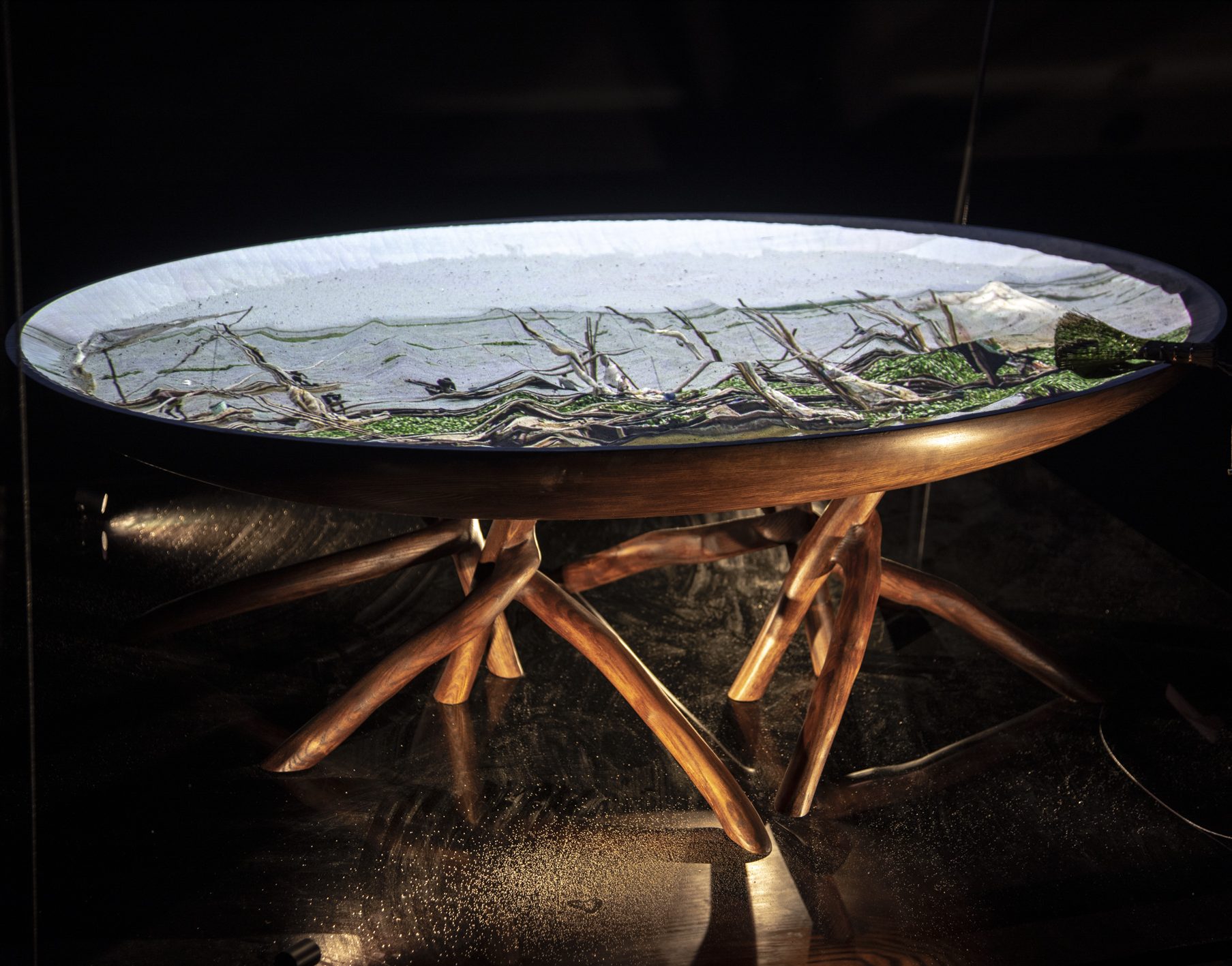
INTERVIEW
A Conversation at the Biennale Architettura 18th International Architecture Exhibition
Dele Adeyemo
Fellow 2022-23
Jennifer Newsom & Jerome Haferd
MAY 20, 2023
“The Laboratory of the Future” Curated by Lesley Lokko
A Conversation at the Biennale Architettura 18th International Architecture Exhibition
Dele Adeyemo
Fellow 2022-23
Jennifer Newsom & Jerome Haferd
MAY 20, 2023
“The Laboratory of the Future” Curated by Lesley Lokko
Foreword by Jerome Haferd, September 2023
I had the pleasure of meeting up with participants Dele Adeyemo and Jennifer Newsom at the opening of the 18th Venice Architecture Biennale to talk about their respective contributions in situ. The Biennale is a convergence of threads, bringing together in physical space these two individuals, already in dialogue through the JAE Fellowship as Fellow (Dele) and Advocate (Jennifer). Their work and our conversation, situated within the geometric “Blackness” of the show, explores ideas of Black Geometry from different orientation points.
Dance of the Mangroves, Adeyemo’s work, and Afterimages by Newsom and her partner Tom Carruthers (Dream The Combine), reside within the Arsenale Exhibition Space. The Arsenale’s capacious former military facility—now a massive series of enfilade chambers draped in near darkness in many areas with works and projections floating in the void—will, I think, be remembered as the most powerful and clear statement of the “Black Biennale.”
Adeyemo’s piece can be found near the entrance, suspended in an eddy-like room within a cavernous black abyss that characterizes the opening rooms of the gallery. The work is finely crafted, mixed-media, and interactive, and can best be described as a divination table. The eccentric ellipse of the table’s “bowl” holds a thin layer of sand which receives a video projection of Nigerian shoal dwellers from above. The form feels simultaneously contemporary and yet laden with cultural lineage and practice. Passersby step up to the table and carefully spread the sand with a broom that Adeyemo has provided.
The physical installations serve as literal orientation points themselves; this interview took place partially in motion, while traversing the cavernous space of the Arsenale, passing numerous exhibits, and weaving a considerable distance to connect the two works and a single conversation. Newsom and Carruthers’ installation dwells deep in the Arsenale and emerges into view is a series of giant tubes and cables that thrust into view as one approaches, cascading out of relatively well-lit chamber walls, disorienting the viewer and casting shadows throughout the gallery—as if it is in motion. Though minimalist and restrained, there is a “hand” to the work that is subtle, developed, and particular.
Perhaps it is fitting that this is my first encounter with Adeyemo and his work—a theoretical research-heavy practice based in the ephemeralities of critical geography, but now approaching a sense of craft and abstraction—while I perceive and consider Newsom’s within the context of Dream The Combine’s lineage of projects: often muscular and structurally expressive as objects, but hiding a deeper interest in perception, movement, (Black) aesthetics of urbanity and rurality, and perhaps even diaspora. One lineage of work that is approaching a cultural expansiveness from a basis in minimalism and craft, and another beginning in the ephemerality of cultural experience, then distilling it into the making of a refined architectural object expanding. It is also fitting that these two practices meet here at this Biennale, which attempts to stitch together the ephemeral, the built, the diasporic, and the futuristic into a more complete and apt framing of architecture for the coming era.
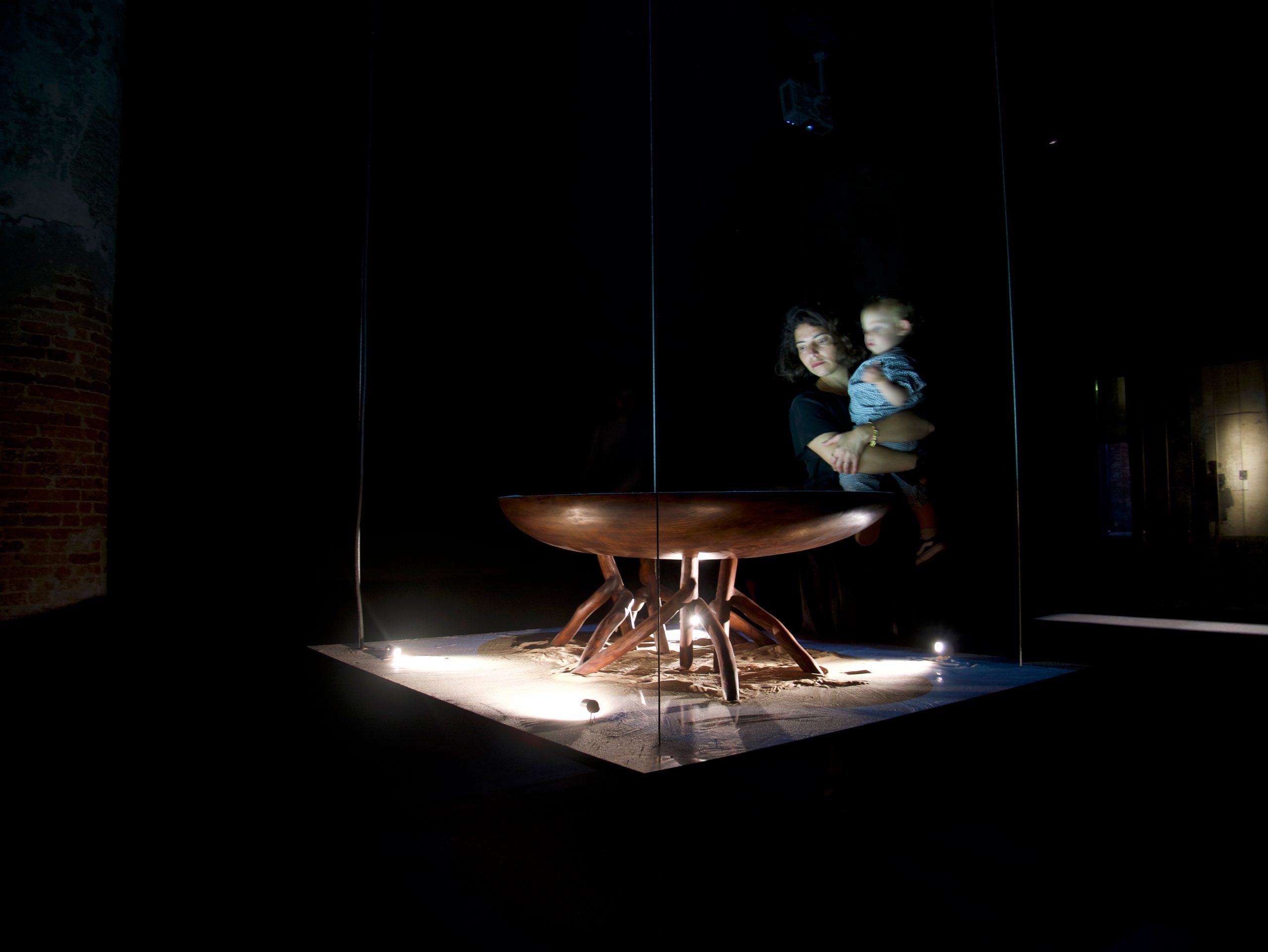
Dele Adeyemo, Dance of the Mangroves, 2023
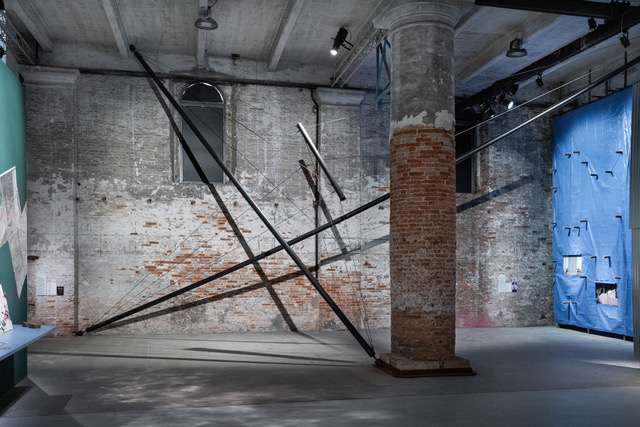
Dream The Combine, Afterimages, 2023
Jennifer Newsom: I just really love the tactility of what you’re doing—even just standing here and watching people interact with it. It has a kind of breath… I love seeing reflections in the water and the rippling of the image projected onto the sand. It’s really quite beautiful. Can you tell us a little bit about the film? Tell us what we’re looking at!
Dele Adeyemo: Yeah. So, in brief, the film the project is called a Dance of the Mangroves. It’s about showing the entangled lifeworlds, the spiritual, social, and ecological lifeworlds of a lagoon, at the heart of the megacity of Lagos. Lagos is known quite well now in popular culture through Afro beats and things like Nollywood. The emergence of Nigerian culture is bringing the megacity of Lagos to the forefront of people’s imaginations. But when people think of the megacity, they generally think of incredibly dense populated spaces and traffic, you know? And this film is really a portrait, like an attempt at a loving portrait of a community right in the center of the megacity, in a community called Oworonshoki.
And right at the center of the community is the lagoon. I’ve been collaborating with people in the community for four or five years, and I recently had the opportunity to go out on the water with the fishermen from the community. As soon as I went out on the water with them, I realized the lagoon itself was a whole other world. From the motorway known as Third Mainland Bridge (that connects the mainland to the islands that house the CBD) the lagoon looks like an empty void in the center of the megacity, when in actual fact it’s teeming with life, ecological as well as social life, where people live either directly on the water or dotted around the edge of the lagoon.
So through collaborating with this community and collaborating with a group of young dancers, who were also community organizers and activists, I started to learn that the kind of sociality that exists within these communities that are in direct connection to the lagoon is a kind of sociality that stems from another logic. Another logic to urban planning, another logic providing spaces that have another worldview.
This other logic exists because these spaces weren’t planned by the forms of colonial urbanization and colonial planning that expanded the city.
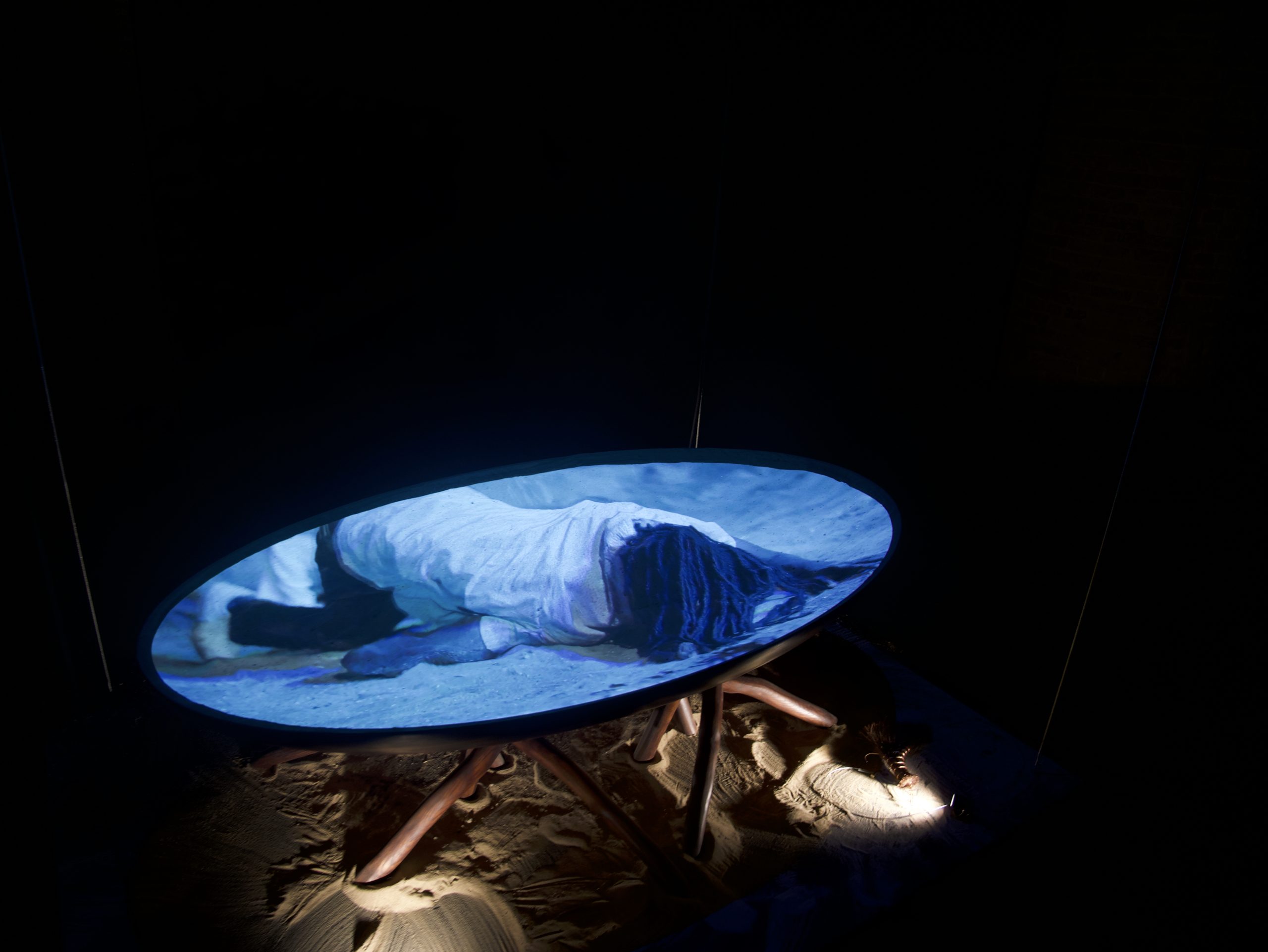
Dele Adeyemo, Dance of the Mangroves, 2023
These spaces were in fact planned by inland settlements like Ile Ife, sending people to migrate, to be adjacent to Lagos in order to trade. But when people traveled there, they weren’t traveling there to become part of the colonial administration. So this space emerged through a kind of native or Indigenous form of planning that persists within these spaces. And so when I started to learn about this community, this space, and how the people arrived there another world came into view. For example, when people traveled, they migrated with their shrines, which are a little like alters encompassing spiritual artifacts, right? But it’s mainly the worldview, it’s mainly this connection to the world of the spiritual, the connection to the world of ancestors that they took with them. So when they’re migrating, they’re also migrating with traditions like masquerade, for example, which is a form of placemaking it’s a technology of society building.
So you have the masquerade and the spiritual shrine, and then there are technologies and knowledges for inhabiting lagoon environments such as the canoe that enable the use of plant life, in particular the mangroves, that’s what people were migrating with. And, of course, the colonial mentality, the colonial form of planning, erases all of that—it separates people from these knowledges. And that’s what makes these spaces like Oworonshoki incredibly valuable, because they appeared along a different line of planning, they actually maintain a lot of these knowledge systems as you see in my film, where the practice of fishing using the mangrove is described. As the fishermen, they cut the branches, they use them to create fish traps called the Akaja. But the community also used the mangroves as medicine. When prepared with certain herbs the bark of the mangrove acts as a prophylactic against malaria.
But when the British arrived, they started cutting the mangrove down and sand filling as a form of urbanization because malaria was the single greatest barrier to colonizing West Africa. The death rate was so incredible the British had to find a solution. And rather than using Indigenous technologies and knowledges, of course…
Jerome Haferd: They eradicated the mangroves.
DA: So yeah, what I’ve realized is that these performance cultures like the ones that you see, in the performance at the end of the film, are a part of a heritage and a lineage that can be understood as form of Indigenous knowledge and Indigenous practices but played out within the contemporary space of the megacity. It’s not an idealized romanticized idea of what Indigeneity is, right? It’s a hybridized lifeworld that’s produced. So that’s what I’ve tried to celebrate with this film.
JH: And I think you’re sort of taking that highly architectural idea and creating a generative object, because now we’re in Venice you constituted another space, here, that’s using an interdisciplinary set of mediums to sort of motivate a performance in a different location. So I’m curious about even how you made this object, how you’re ending with this comment not on a frozen Indigeneity but a sort of generative Indigeneity.
JN: Yes, also it seems as though you are evoking the sand as a kind of carrier. It’s a communicative medium. It’s quite literally the territory on which these performances, these lives are lived. But now it also becomes the device through which colonizing forces are operating in that place, right? It’s like, “We’re going to cut the mangrove and then sand fill it.” And now, here in Venice, the sand becomes an interactive surface. I like how it’s activated in this new context. I’d love it if you’d talk about the construction of this artifact in general, but also the particular choice of materials that you’re using.
DA: Yeah, so first of all, I’ve been working a lot with writing, reflecting through writing. And also reflecting, by creating film. And so this exhibition is an opportunity to reflect on the realisations I arrived at through on writing and making films about community, but in this instance I express these realisations through generative forms. As I was saying to you yesterday I had an opportunity to have a wonderful conversation at lunch with Torkwase Dyson, about a year and a half ago. It was just so inspiring to speak to her because I realized that, in her work, she’s grappling with what I would call, Black geometries.
JN: The triangle, the circle as these expansive and generative shapes.
DA: Yeah. Yeah. Which then becomes trapezoid and curve. And by speaking to her, I understood that geometries and forms can have another inheritance—it doesn’t have to follow the Western canon of modernity, these geometries and forms can come through a kind of Black genealogy. And so that was kind of opening for me.
JH: …and part of a larger research, in a way.
DA: Yeah. And so it really made me think, okay, what other Black geometries are there? What are the African geometries that exist within the space that I’m working with? And so this bowl that I created is inspired by one of the many vessels that appears everywhere for carrying things and for holding and displaying things in the market like grains, rice, garri, or beans. We see large bowl vessels everywhere in the street markets of Lagos. The form of the sculpture is also referencing the technology of the canoe of course, but I’m particularly interested in referencing the technology of the Ifa divination board. In the Ifa divination board, Babalawo (the divination priest) uses sand to draw marks in the process of divination, so it made sense for me to reimagine that connection to sand in the sculpture that I designed to screen my film. In fact, in the process of researching the origin story of Ile-Ife, the ancestral home of Ifa the indigenous belief system of the Yoruba people, I discovered traditional tales that describe the creation of the world by sand being dropped from the sky and spread across the primordial waters. So the shaping of sand and sediments is not just a contemporary practice in the region but is intimately connected to the Ifa worldview.
So I was thinking about all of these things as well as the mangrove forests of course, and the form of the mangrove trees take. This is how I arrived at the idea to create a stand for the divination bowl which was representative of the twisting aerial roots of the mangroves. I wanted to create a joint that created the effect of the wooden legs twisting around each other. So as a design challenge, it’s technically very difficult for the fabricator to make because you can’t exactly see where it’s load bearing.
JN: There’s a multiplicity of how it’s skittering on these legs. It is interesting—a long time ago, I made an object that had a similar multiplicity of base elements. It imbued the upper structure with a kind of unpredictable movement. The multiplicity can give it its own internal choreographic gesture.
DA: And it’s all referencing the more ornate Ifa divination bowls that you see that sit on a carved plinth. So you have a bowl, and then it’ll be on a stand with elaborate carvings of figures, human figures, and symbolic images. So this is really a play on these traditional designs but starting from this idea of the geometry of the vessel and the curve.
JH: And you’ve suspended it and it’s floating in real time. Yeah. Which is where we all, in a way, when you said African geometry, and then you said Black geometry, I think those are two different things.
JN: Hmmm, yeah, I think so too.
JH: It’s the kind of reflection, the liveness of gravity, and the sort of real time juxtaposition of all those things. Yeah. It’s a sort of Black geometry.
JN: I think the platform is a curatorial artifact and the object is your intervention, right? There’s an intersection to the display. We’re contending with all of these presences that are here and now activated. They encounter a new audience who is coming to this with their own histories, their own knowledge, their own ignorances, etc.
What I love about this work is that it has such a strong voice that I think it touches you even if you don’t fully understand all the narratives it may hold. It has such a lush texture, and the imagery is evocative. It’s easy to fall into it. It’s very seductive.
JH: And even without the curatorial gesture of the plinth, you’re contending with gravity, which I think is something you’re both sort of contending with and thinking about as well as (W. E. B.) Dubois , who was working with abstraction, data visualization, and the Black condition. Yeah. And, you know, and we’re here in Venice, to the extent where, I was telling you yesterday, my equilibrium is now almost completely inverted. I’m feeling more, sort of, at home when I’m in motion. And I think there’s a Blackness to that.
DA: On that point, this is a new iteration of a larger project called Wey Dey Move. Wey Dey Move is a Nigerian pidgin term for things change and constantly evolve, but obviously, when people say Wey Dey Move, it also sounds like the way they move. So, there’s these multiple readings, but it also captures a sense of something essential to Blackness, but a particular kind of Lagosian Blackness. The Lagosian experience is very improvisational. People are constantly in motion, constantly changing, constantly responding to changing situations. This movement comes from the natural environment, but it also comes from the social economic environments that people find themselves in. So you have the constant motion of the tides and the changing shape of the coastline.
But you also have the imposed precarity of people’s lives, because of the structural imbalances of the position of precarity that much of Africa is held in which is particularly intensely felt within Lagos. So, to return to the point of this differentiation between Blackness—and I wouldn’t say a differentiation, but rather the nuance—this nuance between Blackness and African-ness is created by the line drawn by modernity, with its founding forms of violence which are generated through transatlantic slavery. Because of my heritage and being born in Nigeria, having a Nigerian father and Scottish mother, growing up here—in the West—and being born there…
Passing viewer: Congratulations!
DA: Oh, thank you.
Another passing viewer: Congratulations, beautiful exhibition.
DA: Oh, thank you. Thank you. Thank you.
…So yeah, because I was born there, I have this sense of my African-ness and yet I grew up in Scotland. So I have this sort of rupture within myself. And it’s because of these structural conditions that though I was born there, I grew up elsewhere. So I’m very interested in that rupture in its many different contexts. I like to talk about the rupture created by the Door of No Return (the last doorway in the slave castle that enslaved subjects would pass through before they were loaded on the slave ships), as operating in all directions, rippling in all directions through space and time, but I’m particularly interested in how modernity unfolds within the African experience. Blackness is articulated differently according to which side of that rupture it was on. I love the way Arthur Jafa talks about Blackness in America as an existence created out of this rupture, and how it was an opportunity to reimagine all kinds of traditional African practices. But that also happened in Africa too, right? It happens within the urban context. It happens in places like Lagos, where traditional life is totally ruptured by slavery and colonialism.
JH: And modernity.
DA: Yeah, and modernity. The separation from traditional practices generates a form of modernity, but one that remains in interaction with the context of Indigenous practices, one that is still in interaction with the land and still present, within the geography.
JH: Which brings us full circle to the fact that no matter where you are, there is a particular landscape that we’re contending with and engaging with, which is where a kind of “Indigenous” practice becomes very specific.
JN: Yeah, but I love how you’re speaking to this idea of a kind of simultaneity—both continuity and rupture exist within this context. I mean, you’re talking with two Americans…
JH: two African Americans…
JN: …two Black Americans. I’ve been thinking about the door of no return in the context of our project Afterimages, also shown in the Corderie building. Our work is an open portal that you pass under and through. The steel structure is two overlapping perspectives, an intersection of two horizons. The work is conceptual, it is an abstraction of two ways of viewing the same figure. Being a witness means you are both part of the physicality of the event but also outside of it, distanced in a way. Our piece is dedicated, in humble gratitude, to Darnella Frazier, the young woman who captured the video of George Floyd’s murder in my hometown. She was there, it had an impact on her own life, but she also was a conduit for seeing and sharing, through images, this unthinkable violence. I think it’s very interesting that we are circling around some of these same issues of rupture, of modernity, of the Black body and its images, of our present condition, but coming from two sides of an ocean.
JH: Yeah. Recently I’ve been looking at graphic representations of the transatlantic slave trade. And, you know, these millions and millions of individuals cascading across that void is a kind of opening, right, even though there’s a sort of psychology of closure of rupture, of break. But that break is also this opening.
JN: I mean, I think that is in some ways what Jafa is talking about.
JH: Which makes me think of your piece, Jennifer! Can we talk about your piece? Should we go over there?
JN: Yes, let’s walk over there; we can walk and talk. This Biennale so beautifully shows how we are all moving in the same present. We’re bringing our various thoughts and trajectories to intersect in this moment, and those ideas will go off into the future. To see how this work is braided together right now is exciting.
Dele, I’m curious to hear more about your experience as a JAE Fellow in preparation for this exhibition. You are a Guest From The Future, according to the curatorial framing. What is it like being here, seeing your work in relation to all the other work that is also here? We can talk about that in dialogue with my work, sure, but also more generally about this contemporary moment where there’s an intersect. These threads will potentially diverge again, but maybe some will still stay entangled. How is this whole process, the year, the fellowship, being here now and projecting into the future affecting you? How are you thinking about these relationships between your work and the things outside of it?
DA: I mean, it’s inspiring for me, it’s great for me to have this dialogue with you. Because, I think we have been discussing this idea of, what is the Black form? What it is, is not something as simple as an aesthetic practice of creating pattern on a façade, not that that isn’t interesting in its own right.
JN: I’m not interested in graphic pattern at all! [laughs]
DA: Yes, that isn’t what we’re interested in. And for me, it was tremendously exciting to be able to engage with you because this is something that you’re also grappling with in your work.
JN: I’m interested in the dry space, a void in legibility. The mark making is like an erasure, a revealing of something that had been hidden. I’m not interested in re-inscription of a certain pattern, graphic, or symbol. Our work is much more open and abstract in my estimation.
JH: Yeah, certainly it’s also not simply the presence of someone Black doing a piece. Exactly, exactly. Which we’ve been talking about a lot.
DA: Yeah, it has to be far more fundamental than that. But I think that’s also the opportunity of creating art, as opposed to having to create living buildings. You know, you’re able to push at these limits. Like when I look at your work, I think about Ralph Ellison’s Invisible Man, I think about jazz, and I think about the strangeness of the urban environment. And going back to that idea of form inspired by Torkwase Dyson’s questions, it makes me think about the strangeness of a Black experience in urban space.
JN: And that there are these infrastructures, these spatial conditions that are meant to alienate us from ourselves.
JH: And disciplinary conditions, pedagogical conditions.
JN: And people often ask us about the violence in our work. We’re not trying to shy away from what’s uncomfortable about it, even as we explore it and try to reckon with it ourselves.
JH: You know, it reminds me of something Walter Hood said, the first time I saw him speak in person, which is we’ve had to walk and chew gum at the same time, right?
JN: Yeah, chew gum, tap dance…[laughs]
JH: And that’s where the Blackness of the work is addressing these issues at a multivalent level. An acknowledgement of violence, of complexity. And of different mediums that that registers on.
JN: I like how you brought in the disciplinary violence because we were talking about that a little bit on the boat yesterday. At a gathering in honor of the Black Reconstruction Collective and in partnership with Deem Journal, Mitch [McEwen] was talking about stepping into the space of this exhibition…
JH: Having to protect oneself from the discipline.
JN: Yes, and not needing to protect oneself from the discipline when you are here. Stepping into the space of this exhibition, you don’t feel that need for protection. It’s like, oh, no, I’m the center.
JH: And not only that I’m the center, but there is an acknowledgement of the wholeness of experience that we contain.
DA: Yeah. There’s a line in Tina Campt’s book Listening to Images in which she talks about the agency of a group of African women who have been photographed that she finds in a colonial archive in South Africa. On one level, it may seem like they’re being photographed under coercion. But then she asks you to look closer at the images, the expressions, the posture of the women. And she uses this term like, there’s a muscular tension in their bodies, in their posture and facial expressions, which reveals their agency and resistance in the moment. This is what I get from looking at your work as well, Jennifer. It represents to me all of these challenges about having to contort and hold your body to suit what is seen as the discipline of architecture whilst overcoming questions about ‘how is a Black architecture relevant? How is the Black experience relevant, architecture is supposed to be universal?’ Your work challenges all these questions.
And I guess I see all that tension not as tension but as energy, as potential kinetic energy.
JN: I appreciate that you say that because I think we certainly thought about this piece through folks’ movements around it through parallax, and we have been referring to the central element as a “figure.” Relative to one horizon, the figure is laying down. Relative to the other horizon, it is standing. And then as you circle around and look back, the figure is in flight. We thought about this piece as a kind of portal. This is the web that we’re in, and we’re all trying to navigate our way through.
JH: Absolutely. And this is where, you know, again, at a visual level, but also sort of like empathic level. If not for the transatlantic slave trade, I wouldn’t exist. Do you know what I mean, to really think about the kind of natural force that is Blackness? Right? And just contending with that tension? You know what I mean?
If not for the violence of Blackness, I wouldn’t be here. Right. So how do we contend with the, with that muscular tension, of the hopefulness of Blackness, the generative Blackness, and the violence all at the same time?
DA: Well, I think I think it’s the generative, I really like…
JH: And the joy.
DA: Yeah, yeah. I mean, so the joy, like the joy… I talk about the dancers in my film, I talk about virtuosic, vibrant outbursts of accumulated tension in their bodies. You know, because of the condition that people are living in… the pressure of the precarity of the urban space, it lives in, as they say, it lives in their bodies, but it flows out in this incredibly generative way. And so I don’t see the violence as a positive, I’m not thankful for the violence that we must overcome, but I also know that there is no perfect state, you know, there’s no perfect state in nature. So, it’s this interplay that’s always at work.
JN: I was just going to say, to make a link back to your film, we’ve been working on an open-ended conversation with the performance artist Jasmine Hearn who has been producing their own research in response to our work. They’ve been spending time with it, doing movements in response to it, and creating an embodiment score. So I think there’s a way in which that kind of muscular tension, that liveness, is part of the work quite literally. It is a movement and moving through. Jasmine’s body has so many different types of knowledge that I don’t necessarily have. It has been powerful to see them move. The visual artist Elle Pérez made a film of Jasmine’s interaction with our work, which also speaks to this kind of buoyancy, liquidity, water, and multiple horizons that are inscribing these worlds. Elle manipulated the camera so the steel, its shadows, and Jasmine’ body were in continual resonance as various horizons in the space of the film. As we stand here, we each bring our own horizon with us. The vanishing point is within each of us.

Dream The Combine, Afterimages (detail of shadows), 2023
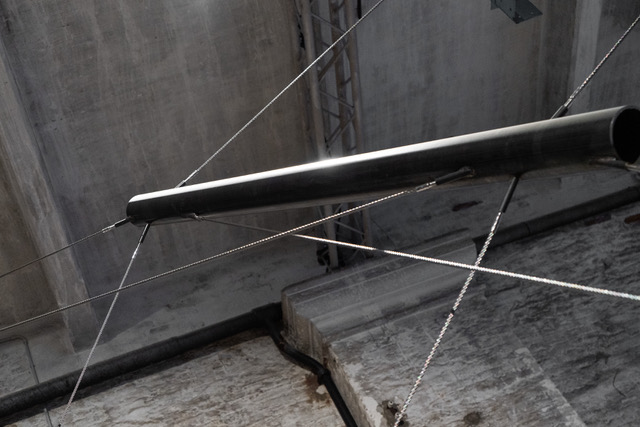
Dream The Combine, Afterimages (detail of central figure), 2023
JH: And practicing that… that constant change of equilibrium.
JN: Yes, this constant negotiation, to go back to what you were saying earlier, and…
JH: …that frequency. So go back to Tina Campt. Which we were discussing with her yesterday on the boat.
JN: Yes, that was so wonderful to be in conversation with Tina! The conversation continued what she spoke about at The Loophole of Retreat, held in Venice the previous October, which I also had the pleasure of attending. That event was also an incredible, generative moment, a nourishing moment. Tina and I talked about frequency as a definable thing that has movement, resonance, and flow.
Dele, we’re using very different material expressions and different forms. But I think it’s interesting that we’re holding a lot of similar attitudes. I keep returning to this metaphor of meeting on either side of the ocean. We’re trying to speak to one another in some way, even though we are not using the same language, the same words. So there’s a kind of a slippage there.
DA: Yeah. The last thing that I will say, because I really must run, I’m late, I’m sorry, but I mean, I really enjoyed this conversation. And, hopefully, we can keep it going. The other thing is, obvious—you are using architectural materials, very industrial architectural materials, but they’re being reassembled in these interesting ways.
And I would love to talk more about it but I really have to go.
JN: The materiality of infrastructure, of modernity. That’s intentional. Yes, to be continued…
DA: I thought that was really amazing.
JN: Me too!
JH: Wonderful.
Dele Adeyemo is a Scottish/Nigerian artist, architect, and critical urban theorist based in London and Lagos. In his creative practice and research, he interrogates the processes embedded in racial capitalism’s spatial production and the contemporary life-worlds in its midst. Through drawing, film, and installation, Adeyemo’s work constitutes a transdisciplinary practice encompassing embodied cultures of movement and circulation to mobilize what he’s calling “the Black radical spatial imaginary.”
Adeyemo’s projects have been presented internationally, including the 13th and 18th Venice Architecture Biennales, the 13th International Architecture Biennale of Sao Paulo, the 5th Istanbul Design Biennial, and the 2nd Edition of the Lagos Biennial. Adeyemo is the recipient of the JAE Fellowship, the Canadian Centre for Architecture & Andrew Mellon Fellowship, and Het Nieuwe Instituut’s Research Fellowship. He is completing a CHASE-AHRC awarded doctoral thesis, titled “Last Dark Continent,” in the Centre for Research Architecture at Goldsmiths, University of London.
Jennifer Newsom is an architect and conceptual artist working across scales in installation, architecture, sculpture, film, drawing, and social practice. In 2013, Newsom and Tom Carruthers cofounded Dream The Combine in Minneapolis, MN. The duo move between the Midwest and Ithaca, NY, where they are faculty at Cornell AAP. They have produced numerous site-specific works that explore metaphor, perceptual uncertainties, and the boundary between real and illusory space. Newsom and Carruthers consider these as frameworks for vision and movement that complicate the relationship between body, space, image, and environment.
Dream The Combine was named a 2023 Emerging Voice by The Architectural League, 2022–2023 Rome Prize Fellows in Architecture by the American Academy in Rome, 2022 Fellows in Architecture and Design by United States Artists, 2021 Visual Artist Fellows by the McKnight Foundation, 2020–2021 J. Irwin and Xenia S. Miller Prize winners by Landmark Columbus, and 2018 MoMA PS1 Young Architects Program winners by The Museum of Modern Art. Their writing and interviews have appeared in the Journal of Architectural Education, Log, Architectural Design, Wallpaper, Metropolis, MasContext, and Reconstructions: Architecture and Blackness in America.
Jerome W. Haferd is an architect, public artist, and educator based in Harlem, New York. He is principal of the award winning Jerome Haferd Studio. Haferd is an assistant professor of architecture at City College’s Spitzer School of Architecture where he codirects the new Place, Memory, and Culture Incubator.
Haferd is a core initiator of Dark Matter U, a transdisciplinary network geared towards new models of design pedagogy and practice. He received the 2022 #BlackVisionaries award as part of a DMU cohort and co-led the DMU Constellation exhibit at the 2022 Lisbon Architecture Trienale : Terra.
Haferd’s practice critically engages built environment projects in both urban and rural contexts, often looking to Black, Indigenous, and other marginalized histories to unlock a new imaginary for architecture, design, and cultural infrastructure. His work on complex sites includes collaborations with the Harlem African Burial Ground, Roots to Sky Collective, The Park Avenue Armory, and the National Black Theatre. The firm recently completed the Sankofa installation in Harlem and is one of the first prize recipients for the International Africatown Design Competition in Mobile, AL with their proposal, “In The Wake.”
I had the pleasure of meeting up with participants Dele Adeyemo and Jennifer Newsom at the opening of the 18th Venice Architecture Biennale to talk about their respective contributions in situ. The Biennale is a convergence of threads, bringing together in physical space these two individuals, already in dialogue through the JAE Fellowship as Fellow (Dele) and Advocate (Jennifer). Their work and our conversation, situated within the geometric “Blackness” of the show, explores ideas of Black Geometry from different orientation points.
Dance of the Mangroves, Adeyemo’s work, and Afterimages by Newsom and her partner Tom Carruthers (Dream The Combine), reside within the Arsenale Exhibition Space. The Arsenale’s capacious former military facility—now a massive series of enfilade chambers draped in near darkness in many areas with works and projections floating in the void—will, I think, be remembered as the most powerful and clear statement of the “Black Biennale.”
Adeyemo’s piece can be found near the entrance, suspended in an eddy-like room within a cavernous black abyss that characterizes the opening rooms of the gallery. The work is finely crafted, mixed-media, and interactive, and can best be described as a divination table. The eccentric ellipse of the table’s “bowl” holds a thin layer of sand which receives a video projection of Nigerian shoal dwellers from above. The form feels simultaneously contemporary and yet laden with cultural lineage and practice. Passersby step up to the table and carefully spread the sand with a broom that Adeyemo has provided.
The physical installations serve as literal orientation points themselves; this interview took place partially in motion, while traversing the cavernous space of the Arsenale, passing numerous exhibits, and weaving a considerable distance to connect the two works and a single conversation. Newsom and Carruthers’ installation dwells deep in the Arsenale and emerges into view is a series of giant tubes and cables that thrust into view as one approaches, cascading out of relatively well-lit chamber walls, disorienting the viewer and casting shadows throughout the gallery—as if it is in motion. Though minimalist and restrained, there is a “hand” to the work that is subtle, developed, and particular.
Perhaps it is fitting that this is my first encounter with Adeyemo and his work—a theoretical research-heavy practice based in the ephemeralities of critical geography, but now approaching a sense of craft and abstraction—while I perceive and consider Newsom’s within the context of Dream The Combine’s lineage of projects: often muscular and structurally expressive as objects, but hiding a deeper interest in perception, movement, (Black) aesthetics of urbanity and rurality, and perhaps even diaspora. One lineage of work that is approaching a cultural expansiveness from a basis in minimalism and craft, and another beginning in the ephemerality of cultural experience, then distilling it into the making of a refined architectural object expanding. It is also fitting that these two practices meet here at this Biennale, which attempts to stitch together the ephemeral, the built, the diasporic, and the futuristic into a more complete and apt framing of architecture for the coming era.

Dele Adeyemo, Dance of the Mangroves, 2023

Dream The Combine, Afterimages, 2023
Jennifer Newsom: I just really love the tactility of what you’re doing—even just standing here and watching people interact with it. It has a kind of breath… I love seeing reflections in the water and the rippling of the image projected onto the sand. It’s really quite beautiful. Can you tell us a little bit about the film? Tell us what we’re looking at!
Dele Adeyemo: Yeah. So, in brief, the film the project is called a Dance of the Mangroves. It’s about showing the entangled lifeworlds, the spiritual, social, and ecological lifeworlds of a lagoon, at the heart of the megacity of Lagos. Lagos is known quite well now in popular culture through Afro beats and things like Nollywood. The emergence of Nigerian culture is bringing the megacity of Lagos to the forefront of people’s imaginations. But when people think of the megacity, they generally think of incredibly dense populated spaces and traffic, you know? And this film is really a portrait, like an attempt at a loving portrait of a community right in the center of the megacity, in a community called Oworonshoki.
And right at the center of the community is the lagoon. I’ve been collaborating with people in the community for four or five years, and I recently had the opportunity to go out on the water with the fishermen from the community. As soon as I went out on the water with them, I realized the lagoon itself was a whole other world. From the motorway known as Third Mainland Bridge (that connects the mainland to the islands that house the CBD) the lagoon looks like an empty void in the center of the megacity, when in actual fact it’s teeming with life, ecological as well as social life, where people live either directly on the water or dotted around the edge of the lagoon.
So through collaborating with this community and collaborating with a group of young dancers, who were also community organizers and activists, I started to learn that the kind of sociality that exists within these communities that are in direct connection to the lagoon is a kind of sociality that stems from another logic. Another logic to urban planning, another logic providing spaces that have another worldview.
This other logic exists because these spaces weren’t planned by the forms of colonial urbanization and colonial planning that expanded the city.

Dele Adeyemo, Dance of the Mangroves, 2023
These spaces were in fact planned by inland settlements like Ile Ife, sending people to migrate, to be adjacent to Lagos in order to trade. But when people traveled there, they weren’t traveling there to become part of the colonial administration. So this space emerged through a kind of native or Indigenous form of planning that persists within these spaces. And so when I started to learn about this community, this space, and how the people arrived there another world came into view. For example, when people traveled, they migrated with their shrines, which are a little like alters encompassing spiritual artifacts, right? But it’s mainly the worldview, it’s mainly this connection to the world of the spiritual, the connection to the world of ancestors that they took with them. So when they’re migrating, they’re also migrating with traditions like masquerade, for example, which is a form of placemaking it’s a technology of society building.
So you have the masquerade and the spiritual shrine, and then there are technologies and knowledges for inhabiting lagoon environments such as the canoe that enable the use of plant life, in particular the mangroves, that’s what people were migrating with. And, of course, the colonial mentality, the colonial form of planning, erases all of that—it separates people from these knowledges. And that’s what makes these spaces like Oworonshoki incredibly valuable, because they appeared along a different line of planning, they actually maintain a lot of these knowledge systems as you see in my film, where the practice of fishing using the mangrove is described. As the fishermen, they cut the branches, they use them to create fish traps called the Akaja. But the community also used the mangroves as medicine. When prepared with certain herbs the bark of the mangrove acts as a prophylactic against malaria.
But when the British arrived, they started cutting the mangrove down and sand filling as a form of urbanization because malaria was the single greatest barrier to colonizing West Africa. The death rate was so incredible the British had to find a solution. And rather than using Indigenous technologies and knowledges, of course…
Jerome Haferd: They eradicated the mangroves.
DA: So yeah, what I’ve realized is that these performance cultures like the ones that you see, in the performance at the end of the film, are a part of a heritage and a lineage that can be understood as form of Indigenous knowledge and Indigenous practices but played out within the contemporary space of the megacity. It’s not an idealized romanticized idea of what Indigeneity is, right? It’s a hybridized lifeworld that’s produced. So that’s what I’ve tried to celebrate with this film.
JH: And I think you’re sort of taking that highly architectural idea and creating a generative object, because now we’re in Venice you constituted another space, here, that’s using an interdisciplinary set of mediums to sort of motivate a performance in a different location. So I’m curious about even how you made this object, how you’re ending with this comment not on a frozen Indigeneity but a sort of generative Indigeneity.
JN: Yes, also it seems as though you are evoking the sand as a kind of carrier. It’s a communicative medium. It’s quite literally the territory on which these performances, these lives are lived. But now it also becomes the device through which colonizing forces are operating in that place, right? It’s like, “We’re going to cut the mangrove and then sand fill it.” And now, here in Venice, the sand becomes an interactive surface. I like how it’s activated in this new context. I’d love it if you’d talk about the construction of this artifact in general, but also the particular choice of materials that you’re using.
DA: Yeah, so first of all, I’ve been working a lot with writing, reflecting through writing. And also reflecting, by creating film. And so this exhibition is an opportunity to reflect on the realisations I arrived at through on writing and making films about community, but in this instance I express these realisations through generative forms. As I was saying to you yesterday I had an opportunity to have a wonderful conversation at lunch with Torkwase Dyson, about a year and a half ago. It was just so inspiring to speak to her because I realized that, in her work, she’s grappling with what I would call, Black geometries.
JN: The triangle, the circle as these expansive and generative shapes.
DA: Yeah. Yeah. Which then becomes trapezoid and curve. And by speaking to her, I understood that geometries and forms can have another inheritance—it doesn’t have to follow the Western canon of modernity, these geometries and forms can come through a kind of Black genealogy. And so that was kind of opening for me.
JH: …and part of a larger research, in a way.
DA: Yeah. And so it really made me think, okay, what other Black geometries are there? What are the African geometries that exist within the space that I’m working with? And so this bowl that I created is inspired by one of the many vessels that appears everywhere for carrying things and for holding and displaying things in the market like grains, rice, garri, or beans. We see large bowl vessels everywhere in the street markets of Lagos. The form of the sculpture is also referencing the technology of the canoe of course, but I’m particularly interested in referencing the technology of the Ifa divination board. In the Ifa divination board, Babalawo (the divination priest) uses sand to draw marks in the process of divination, so it made sense for me to reimagine that connection to sand in the sculpture that I designed to screen my film. In fact, in the process of researching the origin story of Ile-Ife, the ancestral home of Ifa the indigenous belief system of the Yoruba people, I discovered traditional tales that describe the creation of the world by sand being dropped from the sky and spread across the primordial waters. So the shaping of sand and sediments is not just a contemporary practice in the region but is intimately connected to the Ifa worldview.
So I was thinking about all of these things as well as the mangrove forests of course, and the form of the mangrove trees take. This is how I arrived at the idea to create a stand for the divination bowl which was representative of the twisting aerial roots of the mangroves. I wanted to create a joint that created the effect of the wooden legs twisting around each other. So as a design challenge, it’s technically very difficult for the fabricator to make because you can’t exactly see where it’s load bearing.
JN: There’s a multiplicity of how it’s skittering on these legs. It is interesting—a long time ago, I made an object that had a similar multiplicity of base elements. It imbued the upper structure with a kind of unpredictable movement. The multiplicity can give it its own internal choreographic gesture.
DA: And it’s all referencing the more ornate Ifa divination bowls that you see that sit on a carved plinth. So you have a bowl, and then it’ll be on a stand with elaborate carvings of figures, human figures, and symbolic images. So this is really a play on these traditional designs but starting from this idea of the geometry of the vessel and the curve.
JH: And you’ve suspended it and it’s floating in real time. Yeah. Which is where we all, in a way, when you said African geometry, and then you said Black geometry, I think those are two different things.
JN: Hmmm, yeah, I think so too.
JH: It’s the kind of reflection, the liveness of gravity, and the sort of real time juxtaposition of all those things. Yeah. It’s a sort of Black geometry.
JN: I think the platform is a curatorial artifact and the object is your intervention, right? There’s an intersection to the display. We’re contending with all of these presences that are here and now activated. They encounter a new audience who is coming to this with their own histories, their own knowledge, their own ignorances, etc.
What I love about this work is that it has such a strong voice that I think it touches you even if you don’t fully understand all the narratives it may hold. It has such a lush texture, and the imagery is evocative. It’s easy to fall into it. It’s very seductive.
JH: And even without the curatorial gesture of the plinth, you’re contending with gravity, which I think is something you’re both sort of contending with and thinking about as well as (W. E. B.) Dubois , who was working with abstraction, data visualization, and the Black condition. Yeah. And, you know, and we’re here in Venice, to the extent where, I was telling you yesterday, my equilibrium is now almost completely inverted. I’m feeling more, sort of, at home when I’m in motion. And I think there’s a Blackness to that.
DA: On that point, this is a new iteration of a larger project called Wey Dey Move. Wey Dey Move is a Nigerian pidgin term for things change and constantly evolve, but obviously, when people say Wey Dey Move, it also sounds like the way they move. So, there’s these multiple readings, but it also captures a sense of something essential to Blackness, but a particular kind of Lagosian Blackness. The Lagosian experience is very improvisational. People are constantly in motion, constantly changing, constantly responding to changing situations. This movement comes from the natural environment, but it also comes from the social economic environments that people find themselves in. So you have the constant motion of the tides and the changing shape of the coastline.
But you also have the imposed precarity of people’s lives, because of the structural imbalances of the position of precarity that much of Africa is held in which is particularly intensely felt within Lagos. So, to return to the point of this differentiation between Blackness—and I wouldn’t say a differentiation, but rather the nuance—this nuance between Blackness and African-ness is created by the line drawn by modernity, with its founding forms of violence which are generated through transatlantic slavery. Because of my heritage and being born in Nigeria, having a Nigerian father and Scottish mother, growing up here—in the West—and being born there…
Passing viewer: Congratulations!
DA: Oh, thank you.
Another passing viewer: Congratulations, beautiful exhibition.
DA: Oh, thank you. Thank you. Thank you.
…So yeah, because I was born there, I have this sense of my African-ness and yet I grew up in Scotland. So I have this sort of rupture within myself. And it’s because of these structural conditions that though I was born there, I grew up elsewhere. So I’m very interested in that rupture in its many different contexts. I like to talk about the rupture created by the Door of No Return (the last doorway in the slave castle that enslaved subjects would pass through before they were loaded on the slave ships), as operating in all directions, rippling in all directions through space and time, but I’m particularly interested in how modernity unfolds within the African experience. Blackness is articulated differently according to which side of that rupture it was on. I love the way Arthur Jafa talks about Blackness in America as an existence created out of this rupture, and how it was an opportunity to reimagine all kinds of traditional African practices. But that also happened in Africa too, right? It happens within the urban context. It happens in places like Lagos, where traditional life is totally ruptured by slavery and colonialism.
JH: And modernity.
DA: Yeah, and modernity. The separation from traditional practices generates a form of modernity, but one that remains in interaction with the context of Indigenous practices, one that is still in interaction with the land and still present, within the geography.
JH: Which brings us full circle to the fact that no matter where you are, there is a particular landscape that we’re contending with and engaging with, which is where a kind of “Indigenous” practice becomes very specific.
JN: Yeah, but I love how you’re speaking to this idea of a kind of simultaneity—both continuity and rupture exist within this context. I mean, you’re talking with two Americans…
JH: two African Americans…
JN: …two Black Americans. I’ve been thinking about the door of no return in the context of our project Afterimages, also shown in the Corderie building. Our work is an open portal that you pass under and through. The steel structure is two overlapping perspectives, an intersection of two horizons. The work is conceptual, it is an abstraction of two ways of viewing the same figure. Being a witness means you are both part of the physicality of the event but also outside of it, distanced in a way. Our piece is dedicated, in humble gratitude, to Darnella Frazier, the young woman who captured the video of George Floyd’s murder in my hometown. She was there, it had an impact on her own life, but she also was a conduit for seeing and sharing, through images, this unthinkable violence. I think it’s very interesting that we are circling around some of these same issues of rupture, of modernity, of the Black body and its images, of our present condition, but coming from two sides of an ocean.
JH: Yeah. Recently I’ve been looking at graphic representations of the transatlantic slave trade. And, you know, these millions and millions of individuals cascading across that void is a kind of opening, right, even though there’s a sort of psychology of closure of rupture, of break. But that break is also this opening.
JN: I mean, I think that is in some ways what Jafa is talking about.
JH: Which makes me think of your piece, Jennifer! Can we talk about your piece? Should we go over there?
JN: Yes, let’s walk over there; we can walk and talk. This Biennale so beautifully shows how we are all moving in the same present. We’re bringing our various thoughts and trajectories to intersect in this moment, and those ideas will go off into the future. To see how this work is braided together right now is exciting.
Dele, I’m curious to hear more about your experience as a JAE Fellow in preparation for this exhibition. You are a Guest From The Future, according to the curatorial framing. What is it like being here, seeing your work in relation to all the other work that is also here? We can talk about that in dialogue with my work, sure, but also more generally about this contemporary moment where there’s an intersect. These threads will potentially diverge again, but maybe some will still stay entangled. How is this whole process, the year, the fellowship, being here now and projecting into the future affecting you? How are you thinking about these relationships between your work and the things outside of it?
DA: I mean, it’s inspiring for me, it’s great for me to have this dialogue with you. Because, I think we have been discussing this idea of, what is the Black form? What it is, is not something as simple as an aesthetic practice of creating pattern on a façade, not that that isn’t interesting in its own right.
JN: I’m not interested in graphic pattern at all! [laughs]
DA: Yes, that isn’t what we’re interested in. And for me, it was tremendously exciting to be able to engage with you because this is something that you’re also grappling with in your work.
JN: I’m interested in the dry space, a void in legibility. The mark making is like an erasure, a revealing of something that had been hidden. I’m not interested in re-inscription of a certain pattern, graphic, or symbol. Our work is much more open and abstract in my estimation.
JH: Yeah, certainly it’s also not simply the presence of someone Black doing a piece. Exactly, exactly. Which we’ve been talking about a lot.
DA: Yeah, it has to be far more fundamental than that. But I think that’s also the opportunity of creating art, as opposed to having to create living buildings. You know, you’re able to push at these limits. Like when I look at your work, I think about Ralph Ellison’s Invisible Man, I think about jazz, and I think about the strangeness of the urban environment. And going back to that idea of form inspired by Torkwase Dyson’s questions, it makes me think about the strangeness of a Black experience in urban space.
JN: And that there are these infrastructures, these spatial conditions that are meant to alienate us from ourselves.
JH: And disciplinary conditions, pedagogical conditions.
JN: And people often ask us about the violence in our work. We’re not trying to shy away from what’s uncomfortable about it, even as we explore it and try to reckon with it ourselves.
JH: You know, it reminds me of something Walter Hood said, the first time I saw him speak in person, which is we’ve had to walk and chew gum at the same time, right?
JN: Yeah, chew gum, tap dance…[laughs]
JH: And that’s where the Blackness of the work is addressing these issues at a multivalent level. An acknowledgement of violence, of complexity. And of different mediums that that registers on.
JN: I like how you brought in the disciplinary violence because we were talking about that a little bit on the boat yesterday. At a gathering in honor of the Black Reconstruction Collective and in partnership with Deem Journal, Mitch [McEwen] was talking about stepping into the space of this exhibition…
JH: Having to protect oneself from the discipline.
JN: Yes, and not needing to protect oneself from the discipline when you are here. Stepping into the space of this exhibition, you don’t feel that need for protection. It’s like, oh, no, I’m the center.
JH: And not only that I’m the center, but there is an acknowledgement of the wholeness of experience that we contain.
DA: Yeah. There’s a line in Tina Campt’s book Listening to Images in which she talks about the agency of a group of African women who have been photographed that she finds in a colonial archive in South Africa. On one level, it may seem like they’re being photographed under coercion. But then she asks you to look closer at the images, the expressions, the posture of the women. And she uses this term like, there’s a muscular tension in their bodies, in their posture and facial expressions, which reveals their agency and resistance in the moment. This is what I get from looking at your work as well, Jennifer. It represents to me all of these challenges about having to contort and hold your body to suit what is seen as the discipline of architecture whilst overcoming questions about ‘how is a Black architecture relevant? How is the Black experience relevant, architecture is supposed to be universal?’ Your work challenges all these questions.
And I guess I see all that tension not as tension but as energy, as potential kinetic energy.
JN: I appreciate that you say that because I think we certainly thought about this piece through folks’ movements around it through parallax, and we have been referring to the central element as a “figure.” Relative to one horizon, the figure is laying down. Relative to the other horizon, it is standing. And then as you circle around and look back, the figure is in flight. We thought about this piece as a kind of portal. This is the web that we’re in, and we’re all trying to navigate our way through.
JH: Absolutely. And this is where, you know, again, at a visual level, but also sort of like empathic level. If not for the transatlantic slave trade, I wouldn’t exist. Do you know what I mean, to really think about the kind of natural force that is Blackness? Right? And just contending with that tension? You know what I mean?
If not for the violence of Blackness, I wouldn’t be here. Right. So how do we contend with the, with that muscular tension, of the hopefulness of Blackness, the generative Blackness, and the violence all at the same time?
DA: Well, I think I think it’s the generative, I really like…
JH: And the joy.
DA: Yeah, yeah. I mean, so the joy, like the joy… I talk about the dancers in my film, I talk about virtuosic, vibrant outbursts of accumulated tension in their bodies. You know, because of the condition that people are living in… the pressure of the precarity of the urban space, it lives in, as they say, it lives in their bodies, but it flows out in this incredibly generative way. And so I don’t see the violence as a positive, I’m not thankful for the violence that we must overcome, but I also know that there is no perfect state, you know, there’s no perfect state in nature. So, it’s this interplay that’s always at work.
JN: I was just going to say, to make a link back to your film, we’ve been working on an open-ended conversation with the performance artist Jasmine Hearn who has been producing their own research in response to our work. They’ve been spending time with it, doing movements in response to it, and creating an embodiment score. So I think there’s a way in which that kind of muscular tension, that liveness, is part of the work quite literally. It is a movement and moving through. Jasmine’s body has so many different types of knowledge that I don’t necessarily have. It has been powerful to see them move. The visual artist Elle Pérez made a film of Jasmine’s interaction with our work, which also speaks to this kind of buoyancy, liquidity, water, and multiple horizons that are inscribing these worlds. Elle manipulated the camera so the steel, its shadows, and Jasmine’ body were in continual resonance as various horizons in the space of the film. As we stand here, we each bring our own horizon with us. The vanishing point is within each of us.

Dream The Combine, Afterimages (detail of shadows), 2023

Dream The Combine, Afterimages (detail of central figure), 2023
JH: And practicing that… that constant change of equilibrium.
JN: Yes, this constant negotiation, to go back to what you were saying earlier, and…
JH: …that frequency. So go back to Tina Campt. Which we were discussing with her yesterday on the boat.
JN: Yes, that was so wonderful to be in conversation with Tina! The conversation continued what she spoke about at The Loophole of Retreat, held in Venice the previous October, which I also had the pleasure of attending. That event was also an incredible, generative moment, a nourishing moment. Tina and I talked about frequency as a definable thing that has movement, resonance, and flow.
Dele, we’re using very different material expressions and different forms. But I think it’s interesting that we’re holding a lot of similar attitudes. I keep returning to this metaphor of meeting on either side of the ocean. We’re trying to speak to one another in some way, even though we are not using the same language, the same words. So there’s a kind of a slippage there.
DA: Yeah. The last thing that I will say, because I really must run, I’m late, I’m sorry, but I mean, I really enjoyed this conversation. And, hopefully, we can keep it going. The other thing is, obvious—you are using architectural materials, very industrial architectural materials, but they’re being reassembled in these interesting ways.
And I would love to talk more about it but I really have to go.
JN: The materiality of infrastructure, of modernity. That’s intentional. Yes, to be continued…
DA: I thought that was really amazing.
JN: Me too!
JH: Wonderful.
Dele Adeyemo is a Scottish/Nigerian artist, architect, and critical urban theorist based in London and Lagos. In his creative practice and research, he interrogates the processes embedded in racial capitalism’s spatial production and the contemporary life-worlds in its midst. Through drawing, film, and installation, Adeyemo’s work constitutes a transdisciplinary practice encompassing embodied cultures of movement and circulation to mobilize what he’s calling “the Black radical spatial imaginary.”
Adeyemo’s projects have been presented internationally, including the 13th and 18th Venice Architecture Biennales, the 13th International Architecture Biennale of Sao Paulo, the 5th Istanbul Design Biennial, and the 2nd Edition of the Lagos Biennial. Adeyemo is the recipient of the JAE Fellowship, the Canadian Centre for Architecture & Andrew Mellon Fellowship, and Het Nieuwe Instituut’s Research Fellowship. He is completing a CHASE-AHRC awarded doctoral thesis, titled “Last Dark Continent,” in the Centre for Research Architecture at Goldsmiths, University of London.
Jennifer Newsom is an architect and conceptual artist working across scales in installation, architecture, sculpture, film, drawing, and social practice. In 2013, Newsom and Tom Carruthers cofounded Dream The Combine in Minneapolis, MN. The duo move between the Midwest and Ithaca, NY, where they are faculty at Cornell AAP. They have produced numerous site-specific works that explore metaphor, perceptual uncertainties, and the boundary between real and illusory space. Newsom and Carruthers consider these as frameworks for vision and movement that complicate the relationship between body, space, image, and environment.
Dream The Combine was named a 2023 Emerging Voice by The Architectural League, 2022–2023 Rome Prize Fellows in Architecture by the American Academy in Rome, 2022 Fellows in Architecture and Design by United States Artists, 2021 Visual Artist Fellows by the McKnight Foundation, 2020–2021 J. Irwin and Xenia S. Miller Prize winners by Landmark Columbus, and 2018 MoMA PS1 Young Architects Program winners by The Museum of Modern Art. Their writing and interviews have appeared in the Journal of Architectural Education, Log, Architectural Design, Wallpaper, Metropolis, MasContext, and Reconstructions: Architecture and Blackness in America.
Jerome W. Haferd is an architect, public artist, and educator based in Harlem, New York. He is principal of the award winning Jerome Haferd Studio. Haferd is an assistant professor of architecture at City College’s Spitzer School of Architecture where he codirects the new Place, Memory, and Culture Incubator.
Haferd is a core initiator of Dark Matter U, a transdisciplinary network geared towards new models of design pedagogy and practice. He received the 2022 #BlackVisionaries award as part of a DMU cohort and co-led the DMU Constellation exhibit at the 2022 Lisbon Architecture Trienale : Terra.
Haferd’s practice critically engages built environment projects in both urban and rural contexts, often looking to Black, Indigenous, and other marginalized histories to unlock a new imaginary for architecture, design, and cultural infrastructure. His work on complex sites includes collaborations with the Harlem African Burial Ground, Roots to Sky Collective, The Park Avenue Armory, and the National Black Theatre. The firm recently completed the Sankofa installation in Harlem and is one of the first prize recipients for the International Africatown Design Competition in Mobile, AL with their proposal, “In The Wake.”



